Learn How to Play Chess Free Online: Tutorials for Beginners, Intermediate Players & Beyond.



This site is made possible by member support. ❤️
Big thanks to Arcustech for hosting the site and offering amazing tech support.
When you buy through links on kottke.org, I may earn an affiliate commission. Thanks for supporting the site!
kottke.org. home of fine hypertext products since 1998.
Entries for November 2020
How Are You Doing?
As a companion of sorts to the previous post, I ran across this infographic on a site of pandemic resources for Colorado healthcare workers that shows some typical responses to different levels of stress.
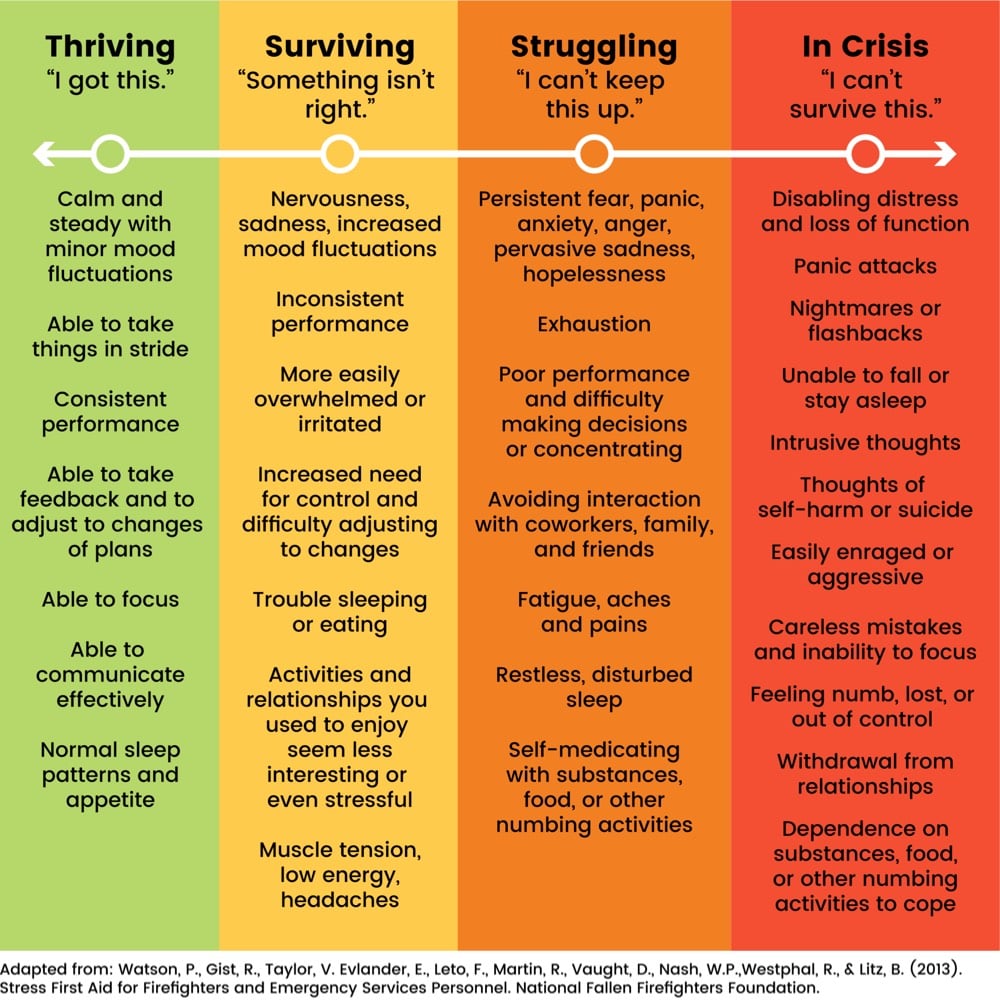
Sometimes having a tough time can make it difficult to determine just how tough a time you’re having. Using a chart like this can help you figure out where you are on the stress continuum (as long as you remember that everyone is different) and then seek out the proper kind of assistance. (via @TheRaDR)
How to Help a Friend Through a Tough Time
Based on the four separate conversations I had with friends this weekend (and reading/watching assorted social media posts), it seems like everyone is really struggling with the pandemic right now, perhaps more so than back in March/April/May. Fatigue is really starting to set in, misinformation is wearing people down, there’s disease and death all around us, it’s tough to keep going towards an ill-defined finish line, and dealing with 9 straight months of grief is just not sustainable. I myself have been all right recently, thankful I’m able to do what I can to support others, but it really varies from week to week.
A year ago, before the pandemic set in, clinical psychologist Kathryn Gordon wrote a piece for Vox on how to help people that you know through a tough time. You may have seen similar advice before — e.g. How Do You Help a Grieving Friend? — but now seems like a good time for a refresher. Here’s one of Gordon’s four tips on how to help:
Ask them how they are feeling. Then, listen non-judgmentally to their response. The simple act of asking someone how they’re doing, with an open-ended question, shows that you care. Listen attentively rather than interrupting or offering your opinion. Ask simple follow-up questions like, “What does that feel like?” or “What has been on your mind as you’re going through this?” This communicates that you genuinely want to know how they’re doing and feel comfortable hearing the truth.
I hope you’re getting the support you need during all of this and are able to find small pockets of time & energy in which to be useful to those around you. ♥
11 facts about coast redwoods. They drink fog, their bark is a foot thick, and some were alive during the Roman Empire. I love redwoods.
Pandemic Stories from Around the World, Fall 2020
My friend Jodi Ettenberg spent a decade traveling around the world, so she’s got friends and followers from all over the place. Over the weekend, she asked her Instagram followers to share their pandemic experiences and she’s been republishing them in Story collections: one, two, three. (You can also find them on her Instagram profile page.) Individually and as a collection, the stories she’s received are fascinating and heartbreaking to read. Almost 11 months into the pandemic — Wuhan’s lockdown began on Jan 23 — folks out there are really struggling and the response of governments around the world has varied widely (and wildly). Here are a few of the stories…check out the links above to read the rest.
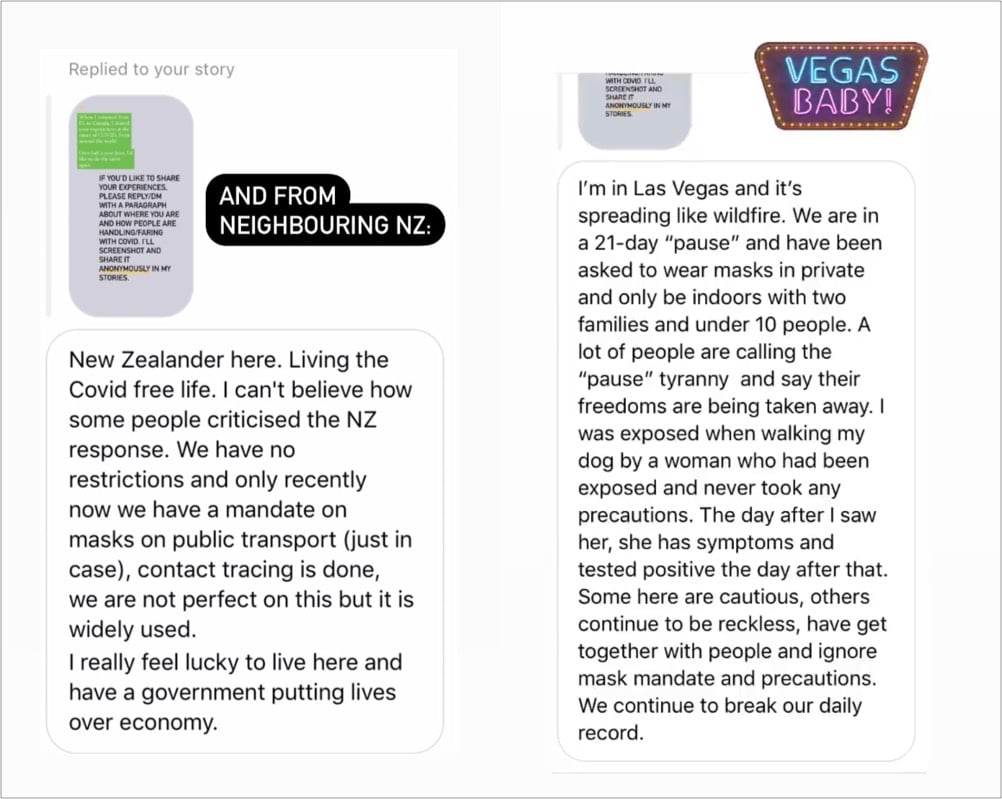

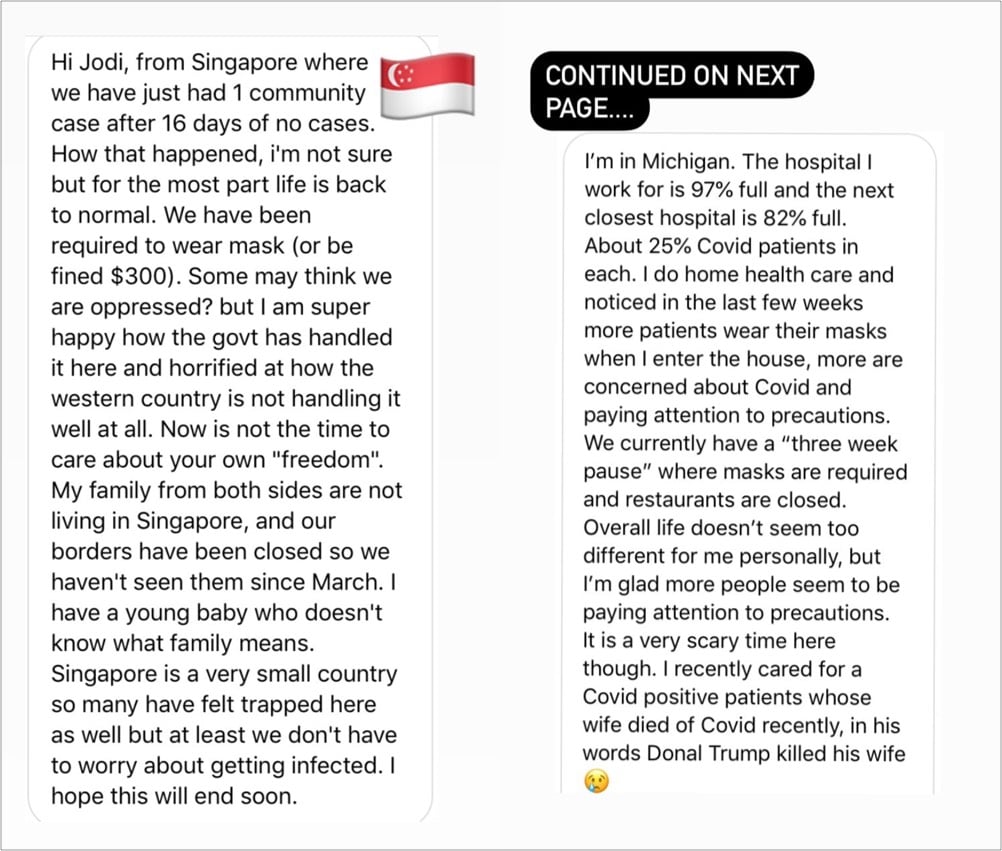
She’s still gathering & sharing stories from people, so send her a DM on Instagram about how things are going in your part of the world if you’d like to participate.
I solicited stories like this from folks back in early April. It’s surreal reading those responses now — so much completely avoidable death and suffering has occurred between then and now.
Speculation: Scented Candle Ratings Down Due to Covid-19 Loss of Smell
After Terri Nelson noticed people complaining online about a lack of scent from newly purchased scented candles, Kate Petrova analyzed Amazon reviews for candles from the past three years and found a drop in ratings for scented candles beginning in January 2020 (compared to a smaller ratings decline for unscented candles).
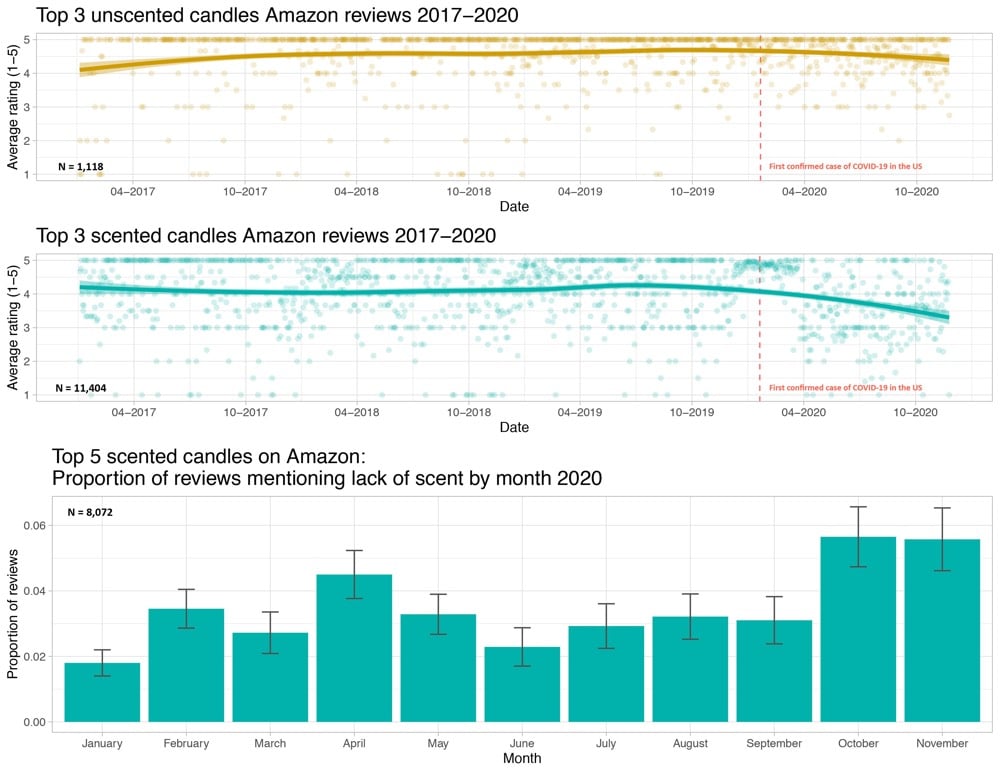
The hypothesis is that some of these buyers have lost their sense of smell due to Covid-19 infections and that’s showing up in the ratings.
1000s of cover videos of Billie Eilish’s Bad Guy, auto-synched by AI. “Machine learning keeps all these covers on the same beat and lets you jump from video to video seamlessly.”
55 Ways White People Say ‘White People’ Without Actually Saying ‘White People’, including “real Americans”, “soccer moms”, “law-abiding citizens”, “taxpayers”, and “families”.
How to Socialize in the Cold Without Being Miserable. “It’s like a chess match — you need to be thinking two or three moves ahead.”
Their Patients Have COVID-19 and Still Think It’s a Hoax. Said one nurse: “We never have had people who thought we were lying to them. It feels like the public doesn’t trust us anymore.”
Rotating Circles Optical Illusion
This is one of the best optical illusions I’ve ever seen: aside from rotating, these circles don’t move.
The left/right/up/down arrows were freaky enough but the in & out arrows really blew a gasket in my brain. For proof that the circles don’t move, blink your eyes quickly as you watch or check out this gif. (via @jagarikin)
The Pandemic Is a Marathon Without a Finish Line. How Can We Win?
With the positive news about the Covid-19 vaccine trials, I assume many of you have started to think about the potential end of the pandemic — what we’ll do, where we’ll go, who we’ll see, and reckon with what’s changed and what’s been lost. I know I have. Alex Hutchinson has written an intriguing piece on what sports science might be able to tell us about the psychology of a situation like the pandemic, where the finish line is poorly defined, ever-changing, or even non-existent.
As it happens, there’s a whole subfield of sports science, at the intersection of physiology and psychology, that explores this terrain. It’s called teleoanticipation, a term coined in 1996 by German physiologist Hans-Volkhart Ulmer to describe how our knowledge of an eventual endpoint (or telos) influences the entirety of an experience. Using endurance sports as their medium, researchers in this subfield have probed what happens when you hide the finish line, surreptitiously move it or take it away entirely. For those of us tempted by promising vaccine updates to start fantasizing about an end to the pandemic, these researchers have some advice: don’t.
Instead, the key seems to be remaining in the moment instead of focusing on the goal.
It turns out that, if you ask yourself “Can I keep going?” rather than “Can I make it to the finish?” you’re far more likely to answer in the affirmative.
This squares with mindfulness practices from Buddhism and Stoicism but also reminds me of a motivational trick I first heard a few years ago: that you can do anything for 10 seconds — and then you just begin a new 10 seconds. Turns out that was popularized by Unbreakable Kimmy Schmidt. Good advice can come from anywhere.
Social Unrest Is the Inevitable Legacy of the Covid Pandemic. “Throughout history, plagues have caused upheaval and revolts. This pandemic will be no different.”
Imagining a Covid-19 Pandemic Memorial
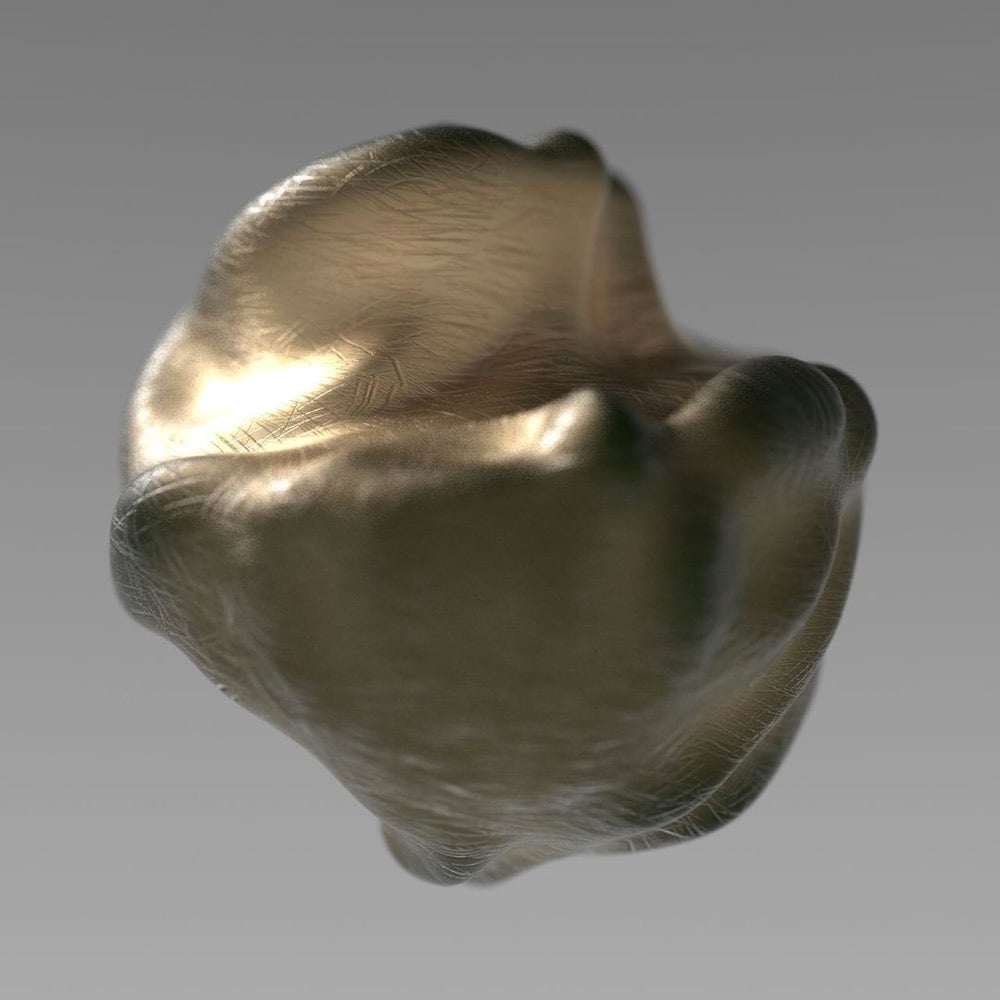
Even though we’re still in the midst of it, The Atlantic commissioned three designers/artists to design hypothetical Covid-19 memorials. Ian Bogost writes:
So this might seem like a strange time to imagine memorializing the pandemic in a formal way. A premature time. Maya Lin’s Vietnam Veterans Memorial was conceived in 1981, six years after the United States had withdrawn from the conflict. Michael Arad and Peter Walker’s 9/11 memorial broke ground at the site of the World Trade Center in 2006, almost five years after the attacks.
But there are downsides to waiting. A traumatic event is an author of its own memorial; as a famous anecdote attests, when a Nazi soldier asked Pablo Picasso if he had made Guernica, the famous painting the artist created during the month following the Luftwaffe’s bombing of its Basque namesake in 1937, Picasso replied, “No, you did.” The feelings, facts, and ideas available during a calamity dissipate as it ebbs. The temptation arises to contain tragedy in a tidy box, closing the book on its history.
Each of the three ideas is intriguing in its own way. I liked how Ronald Rael and Virginia San Fratello (who made those border wall teeter-totters last year) explained their thought process (which Rael elaborated on here).
Quarantine has limited our ability to use smell and touch for communion, so she and Rael became interested in finding a way to replicate the experience. That’s where pennies come in: Copper is an antiviral — a quality with obvious symbolism in the moment — and one that evolves over time, developing a patina as it interacts with water and air. So the pair latched on to it as a material.
Rael San Fratello’s first idea was a pragmatic one: a traditional memorial made of copper molded into a bulbous, organic wall. The copper material would invite the touch lost to quarantine. Outdoors, it could develop a green or purple patina. “If touched constantly,” San Fratello said, “the patina might never occur, and the memorial will remain shiny.”
See also the design for a pandemic memorial already in the planning stages in Uruguay.
An analysis of representation in crossword puzzles. “Our finding: crossword puzzles are dominated by men of European descent, reserving little space for everyone else.”
Our Friend
That’s the trailer for Our Friend, a movie based on the true story told in this Esquire article by Matthew Teague: The Friend: Love Is Not a Big Enough Word.
His wife was just thirty-four. They had two little girls. The cancer was everywhere, and the parts of dying that nobody talks about were about to start. His best friend came to help out for a couple weeks. And he never left.
I remember very clearly that essay and the day I read it — I think about it all the time. I don’t know if the movie is going to be any good (I hope so), but if you’ve never read this essay, carve out some time to do so today.
How to get good at chess. “You need to be endlessly fascinated by it and see its infinite potential. Be willing to embrace the complexity; enjoy the adventure.”
A Framework for the Equitable Allocation of a COVID-19 Vaccine
Now that the preliminary results of various Covid-19 vaccine trials are coming out (and looking promising), attention is turning to the eventual distribution of the vaccines. The logistics of getting the doses out to hospitals, clinics, and doctor’s offices is one concern but so is the question of who should get vaccinated first. Supplies of the vaccines will be limited at first, so we’ll need to decide as a society what distribution method is most fair and is of the most benefit to the greatest number of people.
To this end, and in response to a request by the CDC and NIH, the National Academies of Sciences, Engineering, and Medicine formed a committee to produce a report called Framework for Equitable Allocation of COVID-19 Vaccine. The 252-page report is available to the public for free to read online or download.
In addition several recommendations — including that the vaccine be distributed to everyone free of charge — a central feature of the report is a four-phase system of vaccine distribution, summarized in this graphic:
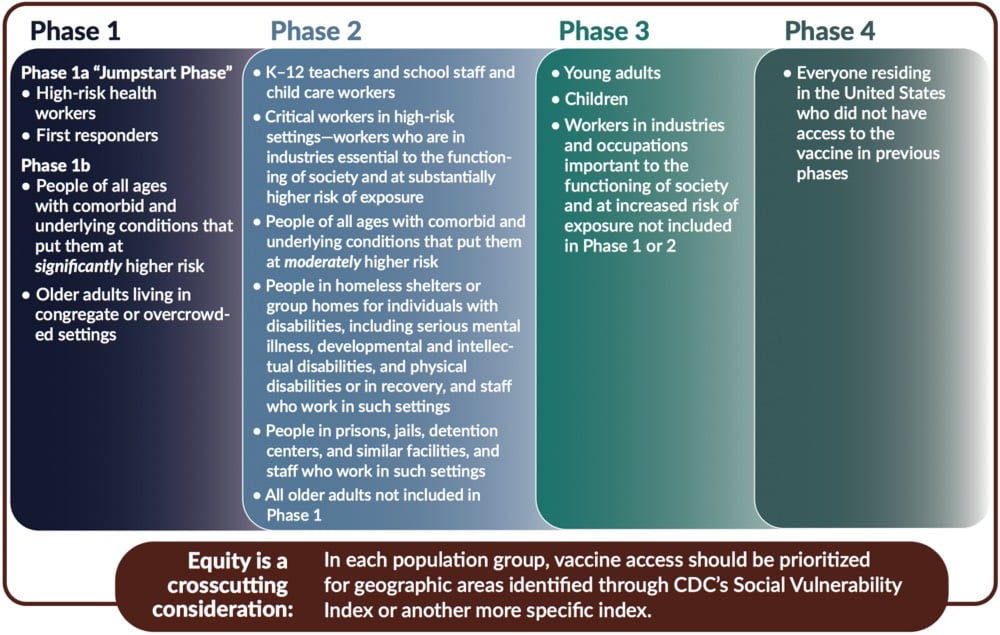
I’d like to stress that this graphic does not show all groups of people included in each phase — please consult the text of the report for that before you go sharing that graphic on social media without context. For example, here’s the full description for “high-risk health workers” in Phase 1a:
This group includes frontline health care workers (who are in hospitals, nursing homes, or providing home care) who either (1) work in situations where the risk of SARS-CoV-2 transmission is higher, or (2) are at an elevated risk of transmitting the infection to patients at higher risk of mortality and severe morbidity. These individuals — who are themselves unable to avoid exposure to the virus — play a critical role in ensuring that the health system can care for COVID-19 patients.
These groups include not only clinicians (e.g., nurses, physicians, respiratory technicians, dentists and hygienists) but also other workers in health care settings who meet the Phase 1a risk criteria (e.g., nursing assistants, environmental services staff, assisted living facility staff, long-term care facility staff, group home staff, and home caregivers). The health care settings employing these workers who are at increased risk of exposure to the virus may also include ambulatory and urgent care clinics; dialysis centers; blood, organ, and tissue donation facilities; and other non-hospital health care facilities. Finally, there are community and family settings where care for infected patients occurs. Not all the workers in these settings are paid for their labor, but, while they are caring for infected people, they all need to be protected from the virus.
Situations associated with higher risk of transmission include caring for COVID-19 patients, cleaning areas where COVID-19 patients are admitted, treated, and housed, and performing procedures with higher risk of aerosolization such as endotracheal intubation, bronchoscopy, suctioning, turning the patient to the prone position, disconnecting the patient from the ventilator, invasive dental procedures and exams, invasive specimen collection, and cardiopulmonary resuscitation. In addition, there are other frontline health care workers who, if they have uncontrolled exposure to the patients or the public in the course of their work, should be in this initial phase. This group includes those individuals distributing or administering the vaccine — especially in areas of higher community transmission — such as pharmacists, plasma and blood donation workers, public health nurses, and other public health and emergency preparedness workers. The committee also includes morticians, funeral home workers, and other death care professionals involved in handling bodies as part of this high-risk group.
The report declines to list specific industries which would be covered in Phase 2’s “critical workers in high-risk settings” but generally says:
The industries in which these critical workers are employed are essential to keeping society and the economy functioning. Since the beginning of the pandemic, millions of people have been going to work and risking exposure to the virus to ensure that markets have food; drug stores have pharmaceutical products; public safety and order are maintained; mail and packages are delivered; and buses, trains, and planes are operating.
Note also the text at the bottom of the graphic: they recommend that within each phase, priority be given to geographic areas where folks are more socially vulnerable in situations like these (e.g. as represented in the CDC’s Social Vulnerability Index).
In developing this phased approach, the committee focused on those who are at the most risk of exposure, severe illness or death, and passing along the virus to others as well as critical workers:
Risk of acquiring infection: Individuals have higher priority to the extent that they have a greater probability of being in settings where SARS-CoV-2 is circulating and of being exposed to a sufficient dose of the virus.
Risk of severe morbidity and mortality: Individuals have higher priority to the extent that they have a greater probability of severe disease or death if they acquire infection.
Risk of negative societal impact: Individuals have higher priority to the extent that societal function and other individuals’ lives and livelihood depend on them directly and would be imperiled if they fell ill.
Risk of transmitting infection to others: Individuals have higher priority to the extent that there is a higher probability of their transmitting the infection to others.
You should read (or at least skim) the full report for more information about the plan and the rationale behind it.
On a personal parting note, as someone who is squarely in the 5-15% of Americans covered in Phase 4 — more specifically: as a 40-something straight white man who non-essentially works from home, isn’t low-income, doesn’t socialize widely even under normal circumstances, and should probably be the very last person on this whole Earth scheduled to be vaccinated under an equitable framework — I am content to wait my turn should the US adopt this framework or something like it.1 Distributing vaccines to those who need them most is absolutely the right thing to do, both ethically and from the standpoint of getting society “back to normal” as quickly as possible and with as little additional death and suffering as possible.
Being that equity often isn’t America’s thing, especially during the pandemic, I could see this going either way. And even if this framework is adopted, those who can afford it will undoubtably be able to procure themselves a dose right alongside those medical workers in Phase 1a.↩
Raising Baby Grey, a Gender-Neutral Child
In this short film from Alex Mallis, we meet a Bronx couple who are raising their child Grey in a gender-neutral way until they make a decision for themselves. No single gender wardrobes or toy collections and they/them pronouns.
Really the goal here is, it’s not about me trying to force anything on Grey, it’s actually the exact opposite. And we don’t know their gender yet, and when they tell us, they’ll tell us. And it might change over time and that’s okay too.
Crispin Long wrote an accompanying piece for the New Yorker on the film.
Watching Grey’s parents navigate this terrain inspires questions about how Grey might one day respond to being brought up this way. Of course, it’s impossible to parent without error, and society does its share of damage, to many of us, without the help of parents. Asking a child to inhabit such a complex and politicized position is demanding, but so is asking a child to perform femininity or masculinity. I get the sense that many trans people would unambivalently prefer to have been raised without the gender they were assigned at birth and its attendant expectations. For me, it’s less clear. If my parents had made every effort to free me from the strictures of the gender binary, I might have rebelled against their liberal piety or appreciated their efforts — or maybe both.
The gadget comeback of 2020. “Did you expect to spend your summer trying to figure out if an air purifier made by a Bluetooth speaker company was going to be sufficient to clear the atmosphere in your isolation pod on an increasingly hostile planet?”
250 Days of Daily Pandemic Drawings
Author and illustrator Edward Carey has been making a drawing a day since the beginning of the pandemic. He recently completed his 250th drawing, with “no end in sight, alas”. He’s posting each day’s drawing to Instagram; here are a few of my recent favorites:

And the whole lot laid out on the floor:
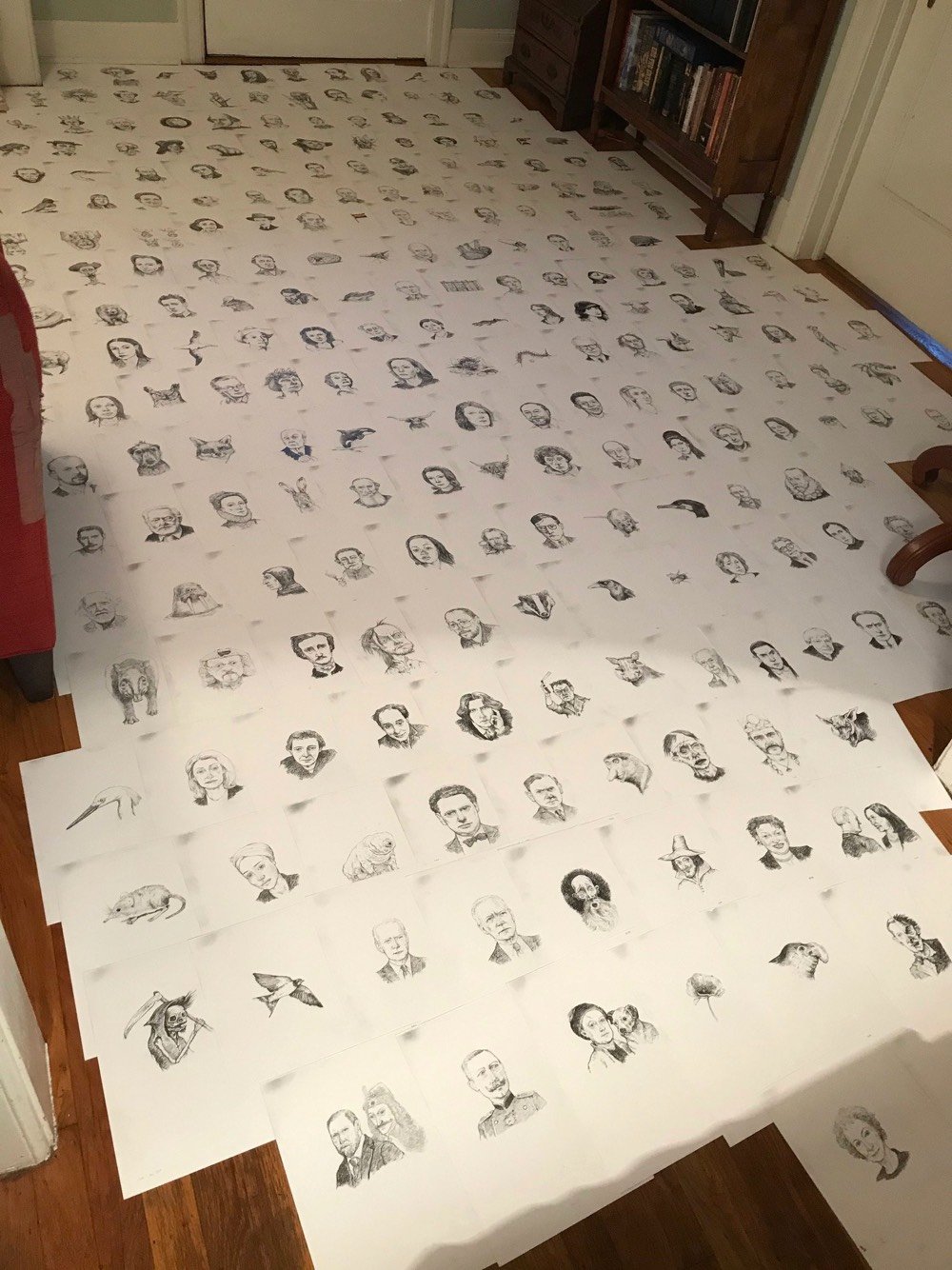
That’s so many days. (via austin kleon)
Ernest Cline’s Ready Player Two is out today. “Days after winning OASIS founder James Halliday’s contest, Wade Watts makes a discovery that changes everything.”
Tracking Pre-Pandemic “Lasts” and Post-Lockdown “Firsts”
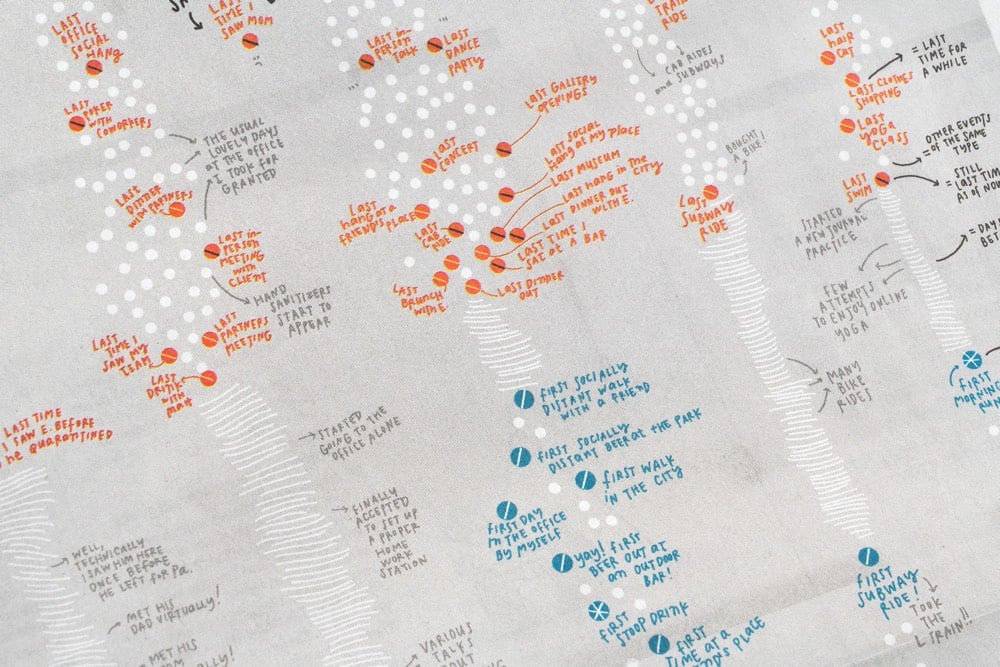
For the print version of the NY Times from this past Sunday, information designer Giorgia Lupi created a hand-drawn visualization that “tracks the last time [she] did something before the pandemic hit, and the first time she did something new with social distancing”.
Our lives have been transformed during the Covid-19 pandemic as the activities we used to do every day have been put on hold and new, socially distanced routines have taken their place. Pentagram partner Giorgia Lupi documents these changes in her own life in a data visualization commissioned by The New York Times for the cover of its “At Home” section, which runs as part of the newspaper’s Sunday edition. The hand-drawn visualization is a personal timeline that tracks the “last” time Giorgia did something before the pandemic hit, and the “first” time she did something new as she started to emerge from lockdown.
Not hand-drawn, but I remember pretty clearly what my lasts were:
- Last movie (w/ kids): Onward in mid-March
- Last movie (solo): Portrait of a Lady on Fire in mid-March
- Last visit to NYC: late October 2019
- Last trip: Vietnam/Singapore/Qatar in Jan/Feb 2020
- Last restaurant (solo): a forgettable ramen place in Burlington in mid-March
- Last restaurant (w/ a friend): better local ramen place in early March
- Last cocktail bar: Bar Stories in Singapore in early February
- Last museum: Museum of Islamic Art in Doha, Qatar in early February
I don’t remember my firsts as well, although one that sticks out is eating french fries (take-out) in July. On a normal day, french fries are delicious but when you haven’t had them in months, they are otherworldly.
Helicopter pilot finds “strange” monolith in Utah wilderness. “I’m assuming it’s some new wave artist or something or, you know, somebody that was a big 2001: A Space Odyssey fan.”
The Birther Myth Stuck Around For Years. The Election Fraud Myth Might Too. “A significant number of Americans currently believe the 2020 election was stolen, even though it wasn’t.”
Rebecca Solnit: We Don’t Need to Meet Nazis Halfway
Writing for Lithub, Rebecca Solnit on On Not Meeting Nazis Halfway.
Supreme Court Justice Samuel Alito just complained that “you can’t say that marriage is a union between one man and one woman. Now it’s considered bigotry.” This is a standard complaint of the right: the real victim is the racist who has been called a racist, not the victim of his racism, the real oppression is to be impeded in your freedom to oppress. And of course Alito is disingenuous; you can say that stuff against marriage equality (and he did). Then other people can call you a bigot, because they get to have opinions too, but in his scheme such dissent is intolerable, which is fun coming from a member of the party whose devotees wore “fuck your feelings” shirts at its rallies and popularized the term “snowflake.”
Nevertheless, we get this hopelessly naive version of centrism, of the idea that if we’re nicer to the other side there will be no other side, just one big happy family. This inanity is also applied to the questions of belief and fact and principle, with some muddled cocktail of moral relativism and therapists’ “everyone’s feelings are valid” applied to everything. But the truth is not some compromise halfway between the truth and the lie, the fact and the delusion, the scientists and the propagandists. And the ethical is not halfway between white supremacists and human rights activists, rapists and feminists, synagogue massacrists and Jews, xenophobes and immigrants, delusional transphobes and trans people. Who the hell wants unity with Nazis until and unless they stop being Nazis?
Reading this, I was reminded of the paradox of tolerance:
Unlimited tolerance must lead to the disappearance of tolerance. If we extend unlimited tolerance even to those who are intolerant, if we are not prepared to defend a tolerant society against the onslaught of the intolerant, then the tolerant will be destroyed, and tolerance with them.
And also, I can’t remember where I heard this recently, but it’s perhaps worth noting that in game theory (I know, I know), when you’re dealing with an iterated prisoner’s dilemma situation (where two competitors are engaged in repeated confrontation), one of the the best strategies is called generous tit-for-tat. Playing a generous tit-for-tat strategy means cooperating on the first move and then mirroring whatever the other player did on their previous move — but, crucially, occasionally cooperating after an attack as a opening to potential future collaboration. So, if the other party cooperates, so do you. And if the other party attacks, attack back…but not every time. Attempting to collaborate in the face of repeated attack leaves the door open to reestablish a virtuous cooperation cycle. The real world of national politics is not quite so simple, but it seems like a shift in strategy for progressives might be in order. (via christopher jobson)
How to make an AC/DC song in 30 seconds. “What’s that? Look out! Dog on the road!”
The Benefits of Collecting - “One Thing Leads to Another”
This video is a lovely little rumination by Iancu Barbarasa “about collecting, cycling caps, art and design, personal connections and why it’s worth doing something for a long time, even if the benefits are not clear at first.”
Many think some people are special but usually those people just put a lot more time in it than others. This applies to sports, arts, almost everything. It’s worth doing something for a long time, even if the benefits are not always clear. Good surprising things come out of it. You also learn about yourself in the process.
His inspiration in doing the film was to “inform, delight, and inspire”:
I mentioned above Milton Glaser’s “inform and delight” definition of art. It’s brilliant, but I always felt something was still missing from it. So I’d say that art — and any creative’s work — should aim to “inform, delight and inspire”. Hopefully my film will inspire people to start something of their own, or share what they’re already doing with other people. That would bring joy to everyone, and there’s never too much of it.
You can check out Barbarasa’s cycling cap collection on Instagram. I have never been much of a collector, but my 22+ years of efforts on this site (collecting knowledge/links?) and my sharing of photos on Flickr/Instagram over the years definitely have resulted in some of the same benefits.
Recommended: this You’re Wrong About episode about the Electoral College w/ special guest @jbouie. I particularly enjoyed the “what if?” discussion – it’s not so straightforward what the result of EC abolishment would be on national elections.
“I Lived Through A Stupid Coup. America Is Having One Now.”
Indi Samarajiva on living through a stupid political coup in Sri Lanka and a warning to Americans.
Two years ago, I lived through a coup in Sri Lanka. It was stupid. The minority party threw chili powder at everyone in Parliament and took over by farce. Math, however, requires a majority and the courts kicked them out. They gave in. We’d been on the streets for weeks but yay, we won.
No.
I didn’t know it at the time, but we had already lost. No one knew — but oh my God, what we lost. The legitimate government came back but it was divided and weak. We were divided and weak. We were vulnerable.
Four months later, on Easter Sunday, some assholes attacked multiple churches and hotels, killing 269 of us. My wife and kids were at church, I had to frantically call them back. Our nation was shattered. Mobs began attacking innocent Muslims. It was out of control. The coup broke our government, and four months later, that broke us.
The coup was a farce at the time but how soon it turned to tragedy. They called it a constitutional crisis, but how soon it became a real one. Right now, the same thing is happening to you. I’m trying to warn you America. It seems stupid now, but the consequences are not.
See also Samarajiva’s “I Lived Through Collapse. America Is Already There.”
Don’t Eat Inside a Restaurant. “Each of us, to get through this terrible time, has clung to some coronavirus factoid or another that we believe protects us. Here’s mine: The odds of catching the coronavirus are about 20 times higher indoors than outdoors.”
Oxford-AstraZeneca’s Covid-19 Vaccine Up to 90% Effective
Preliminary results from the trials of the Covid-19 vaccine jointly developed by the University of Oxford and AstraZeneca indicate that the vaccine’s overall efficacy is 70% but that a regimen that calls for a lower first dose is 90% effective.
The preliminary results on the AstraZeneca vaccine were based on a total of 131 Covid-19 cases in a study involving 11,363 participants. The findings were perplexing. Two full doses of the vaccine appeared to be only 62% effective at preventing disease, while a half dose, followed by a full dose, was about 90% effective. That latter analysis was conducted on a small subset of the study participants, only 2,741.
Hopefully more study will be done on that dosage question. From the AP:
“The report that an initial half-dose is better than a full dose seems counterintuitive for those of us thinking of vaccines as normal drugs: With drugs, we expect that higher doses have bigger effects, and more side-effects,” he said. “But the immune system does not work like that.”
The seemingly lower efficacy comes with some perhaps significant benefits: this vaccine is cheaper to produce and doesn’t require any special refrigeration.
The vaccine can be transported under “normal refrigerated conditions” of 2 to 8 degrees Celsius (36 to 46 degrees Fahrenheit), AstraZeneca said. By comparison, Pfizer plans to distribute its vaccine using specially designed “thermal shippers” that use dry ice to maintain temperatures of minus-70 degrees Celsius (minus-94 degrees Fahrenheit).
The Pfizer and Moderna vaccines were pretty similar in many respects and this one seems quite different. These results were just released a few hours ago, so it will be interesting to follow the debate and expert commentary on this. Stay tuned…
Update: This is amazing: the seemingly more effective 1/2 dose + full dose regimen was a mistake.
Around the time when Astra was initiating its partnership with Oxford at the end of April, university researchers were administering doses to trial participants in Britain.
They soon noticed expected side effects such as fatigue, headaches or arm aches were milder than expected, he said.
“So we went back and checked … and we found out that they had underpredicted the dose of the vaccine by half,” said Pangalos.
A far smaller number of participants was given the initial half-dose, so more research will need to be done to determine if this mistake will be added to the long list of scientific discoveries made because of errors. There’s a good piece in Nature that talks about what we know and don’t know about the vaccine results so far along with some informed speculation.
But, if the differences are bona fide, researchers are eager to understand why. “I don’t think it’s an anomaly,” says Katie Ewer, an immunologist at Oxford’s Jenner Institute who is working on the vaccine. “I’m keen to get into the lab and start thinking about how we address that question.” She has two leading theories for why a lower first dose might have led to better protection against COVID. It’s possible that lower doses of vaccine do a better job at stimulating the subset of immune cells called T cells that support the production of antibodies, she says.
Another potential explanation is the immune system’s response against the chimpanzee virus. The vaccine triggers an immune response not only to the SARS-CoV-2 spike protein, but also to components of the viral vector. It’s possible that the full first dose blunted this reaction, says Ewer. She plans to look at antibody responses against the chimpanzee virus to help address this question.
Update: A short thread by Dr. Natalie Dean, which leads with “AstraZeneca/Oxford get a poor grade for transparency and rigor when it comes to the vaccine trial results they have reported”.
On the sanctity of American marriage. “I believe that marriage is a lasting partnership between one person without health insurance and one person who gets pretty good coverage through work.”
Tom Stoppard and the Last Crusade
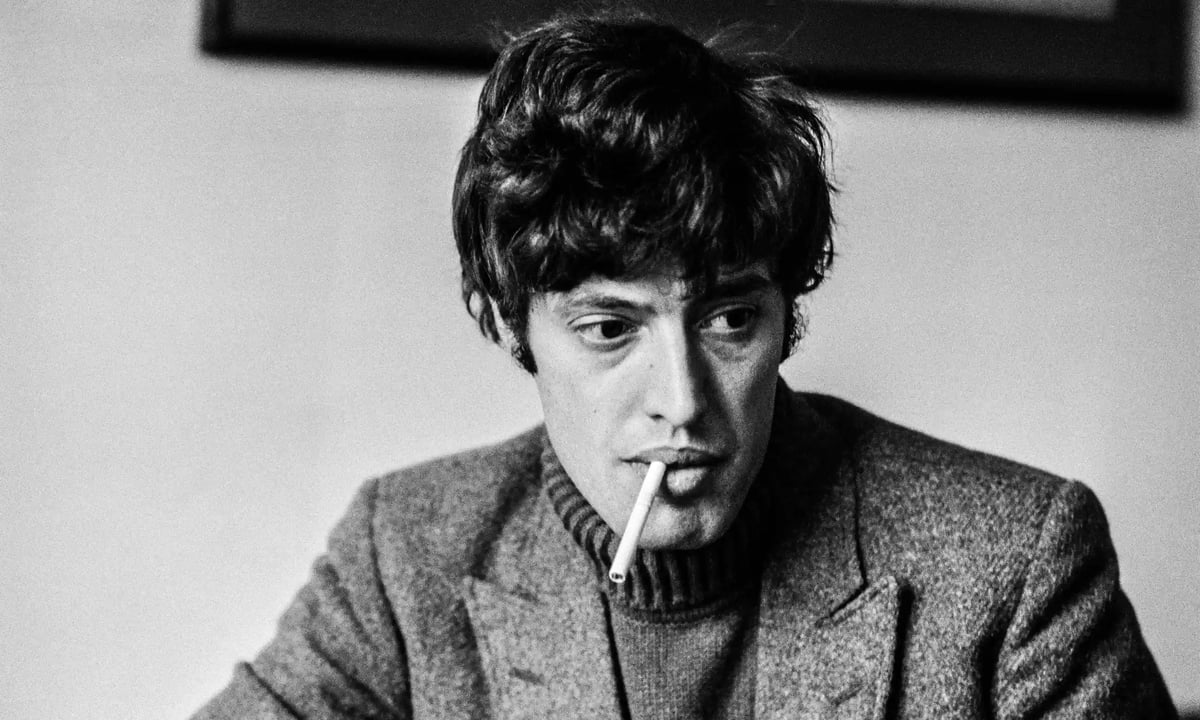
Hermione Lee has written an authorized biography of playwright, screenwriter, translator, and man of letters Tom Stoppard, called Tom Stoppard: A Life. It was released in the United Kingdom on October 1st and should appear in the United States on February 23, 2021.
Here’s an excerpt from the core of Kate Kellaway’s glowing review in The Guardian:
“He put on Englishness like a coat,” Lee writes - and one imagines a particularly dashing coat because Stoppard compensated for his reserve by being an unretiring dresser (a recent photograph shows him, in his 80s, still modishly draped). But the English coat was possibly over-buttoned. Stoppard had an exile’s gratitude to England. He found his boarding school in 18th-century Okeover Hall “paradise”. Yet Lee qualifies the received idea - an oversimplified, dismissive slur - of Stoppard as unswervingly conservative. For a start, he is too entertaining to be stuffy…
His championing of political causes is shown to have stemmed more from empathy with individuals than from abstract ideals. His support for Belarus Free Theatre makes particularly fascinating reading, as does the account of his friendship with Václav Havel, Czech playwright and president. Havel is presented as the person Stoppard might have been had he not become an Englishman.
Lee’s studies of the plays are masterly - especially of Rosencrantz and Guildenstern Are Dead (1966) and Arcadia (1993) - and her book will be a formidable resource for Stoppard enthusiasts. She makes a persuasive case for the importance of emotion, challenging - even in the early work - the old complaint that Stoppard is all head and no heart. Jumpers is “a sensational exercise in mental acrobatics” but also “a play of grief and love. It carries the sadness and the guilt of living in a malfunctioning marriage with a wife who is having a breakdown and it opened two days after his divorce.”
The British edition from Faber & Faber is 992 pages long and weighs 1.33 kilograms (about three pounds). It also retails for £30 in the UK, about 40 USD (used to be more, but the exchange rate has been low—point is, it’s an expensive book). Mercifully, Knopf’s US hardcover will be only 897 pages and cost $37.50, with weight unchanged.
It’s a big book by a biographer known for big books about major literary figures, sadly mostly dead. Stoppard is very much alive, and although quite private, agreed to sit for hours of interviews over a course of years. Lee was also able to interview Stoppard’s friends and colleagues, including actress Felicity Kendal (who starred in multiple Stoppard plays, including in roles written for her), director Trevor Nunn (in charge of three of Stoppard’s world premieres), and filmmaker Steven Spielberg.
This last might seem like an odd choice, but Spielberg and Stoppard have multiple points of contact. Stoppard wrote the screenplay for Spielberg’s Empire of the Sun, and served as an uncredited ghostwriter on Indiana Jones and the Last Crusade. In fact, not only was Stoppard not credited, the lack of credit was actually given to a pseudonym, “Barry Watson.”
Everything suggests that Stoppard’s contributions to the film were substantial. In a brief oral history of The Last Crusade, now lost to linkrot but still preserved by the Wayback Machine, Spielberg says, “Tom is pretty much responsible for every line of dialogue.”
Last year, narrative analyst Mike Fitzgerald broke down in detail differences between a draft version of the screenplay by credited writer Jeffrey Boam and the published draft, including revisions by Spielberg and a heavy rewrite by Stoppard. (You can actually download both versions of the screenplay on Fitzgerald’s site.) Again, Stoppard contributed not just lines of dialogue, but new scenes, a new structure, and changes in characterization.
Vast enhancements were made to every element of the story - character, plot, pace, humor, action, tone, clarity, dialogue. The result is a markedly more coherent, charming, and enduring script that truly belongs in a museum. I suspect that, absent the final revisions, this film would have been regarded by audiences as inferior to its antecedent sequel THE TEMPLE OF DOOM in tone, wit, and entertainment value…
TIGHTENING: The revised draft is 15 pages shorter, though material was not arbitrarily removed just to cut pages. I found 19 instances of scenes or beats being cut, 6 superfluous characters removed, several jokes deleted, and dialogue often pared down. Each of these extractions had a clear purpose to it, whether streamlining the plot, quickening the pace, avoiding redundancies, or simply that the material in question was superfluous and distracting. Note that the revised draft has also ADDED a substantial amount of new scenes, beats, jokes, and dialogue, so in order to counterbalance the new material and cut 15 pages, an ample sum of script was removed…
DIALOGUE: One of Stoppard’s most obvious revisions is to vastly refine the dialogue, and only by reading both drafts side by side is it possible to study those differences. I would ballpark that 80% of the lines have been substantially changed.
HUMOR: This manifests largely in the dialogue, but also in sight gags, character actions, edit points, and streamlining moments to make the jokes land with more precision. The quality of humor is also refined, by removing coarse innuendo and making the jokes smarter and less predictable.
Stoppard was responsible for reshaping one of my favorite scenes in the film. At one point, Henry (Sean Connery’s character) was going to use Indy’s gun (down to just one bullet) to shoot at the seagulls, who would in turn fly into the engines of the plane pursuing them and make it crash. Stoppard had Henry chase them with his umbrella instead.
(The Charlemagne quote is totally made up. Unclear whether Henry Jones is supposed to believe that it’s real.)
Stoppard emphasized elements of faith and history in the story. For example, he rewrote the character of Kazim, changing him from a Nazi stooge to a protector of the grail, and invented the Brotherhood of the Cruciform Sword.
Stoppard also rewrote Henry’s dialogue during the cavern collapse to have him finally call his son by his chosen name, Indiana.
One last thing: if you watch The Last Crusade now, as opposed to thirty years ago, certain things stand out. They used a lot of projected backgrounds. Those don’t look great. More substantively, the Nazis, while generally faithful to their portrayal in Raiders of the Lost Ark, plus some updates, feel pretty… thin. They’re bad guys, evil and a little scary, but you’d be forgiven if you came away from the movie thinking the problem with the Nazis was that they liked to burn books and despoil antiquities, while good people love libraries and museums. That ain’t it.
Stoppard was born Tomás Straüssler, in 1937, in Zlín, Czechoslovakia. In 1939, his parents, nonpracticing Jews, fled the Nazi invasion to Singapore. His father was killed in 1942 when the Japanese Air Force bombed Singapore, and Stoppard has no memory of him; Tom, his mother Marta, and his brother succeeded in reaching India, where he lived until 1946. His new stepfather, Major Kenneth Stoppard, was an antisemite; his mother hid her and her children’s Jewishness to be accepted by him and his circle, now in England.
Three of Stoppard’s aunts, all four of his grandparents, and his great-grandmother all died in the Holocaust. And Stoppard did not know this about his extended family until 1993, four years after the release of Indiana Jones and the Last Crusade.
It is tempting to ask, if Stoppard had been fully aware of and fully embraced his central European and Jewish roots, as he was when he wrote his new play Leopoldstadt, whether his approach to the Nazis, or the very Christian, very English themes of the Grail legend, or even the son striving to be reconciled to his father, might have been substantively different.
In many ways, the Grail legend was perfect for Stoppard: more English than the English, but still a little resistant, a little outside the nation’s own history. A crusade, a quest, a reclamation, a reconciliation.
This saga of the Craigslist Pig Couch—which has been circulating in various listings since at least 2016—is intriguing in its own right. But what really nails the story are the dry, perfectly shaped sentences, one after another
The volunteers, coders, designers, coordinators, and journalists behind The @COVID19Tracking Project are some of the genuine heroes of this year. Here’s how they came together to do a job the US federal government can’t or won’t do:
The Moral Calculus of COVID-19

COVID-19 has required all of us to scrutinize our actions and sacrifice our desires and even our obligations in order to keep ourselves and those around us safe. I want to examine two cases where reasonable, well-informed, and influential people make entirely different choices based on largely similar evidence.
You may have heard that MSNBC host Rachel Maddow has been quarantining at home following close contact with a person who had tested positive for COVID-19. You may have also heard that last night, Maddow returned to her show (still filming from home) to reveal that this person was her partner of 20+ years, artist/photographer Susan Mikula. Mikula is recovering, but at at least one point, the couple genuinely feared for her life. Maddow herself is still testing negative; with Mikula in much less danger and Maddow nearing the end of quarantine, they felt it was time to open the curtain on their experience.
If you haven’t seen it already, I’d like you to watch the video of Maddow describing her experience of living with a loved one who is suffering from COVID-19, whom you have to care for but cannot touch without grave risk to yourself, and then to others. (It is about Mikula’s own experience, but it’s really much more about Maddow’s experience, for good reason.)
Here’s a quick excerpt, if you want a textual preview (via Vulture):
“Just believe me: Whatever you have calculated into your life as acceptable risk, as inevitable risk, something that you’re willing to go through in terms of this virus because statistically, hey probably, it will be fine for you and your loved ones, I’m just here to tell you to recalibrate that,” [Maddow] warned. “Frankly, the country needs you to recalibrate that because broadly speaking, there’s no room for you in the hospital right now.”
She cites hospitals being overwhelmed with a “50 percent” increase in patients “in two weeks.” While it may be easy to risk your own life, the virus doesn’t let you make the choice. “What you need to know is whoever’s the most important person in your life, whoever you most love and most care for and most cherish in the world, that’s the person who you may lose and who you may spend weeks up all night freaking out about and calling doctors all over the place and over and over again all night long, trying to figure out how to keep that person breathing and out of the hospital,” she said. “Whatever you’re doing, however you’ve calibrated risk in your life, don’t get this thing.”
Another moment worth noting in the video is shortly after she begins. Maddow is interrupted by a recurring beeping noise in a room off-camera. She has to attend to it herself, in the middle of a live television show, because there’s no one else at home who can do it. She takes off her microphone and earpiece, then has to put it back on. After already revealing at the beginning of the show that she’s not wearing makeup—she doesn’t know how to apply it herself, and no one can help her—it’s a nice peek behind the scenes.
I don’t know if everyone always understands how much work it takes it is to perform for live television: how many accessories you need, how much support is required. People don’t see what you have to look like, sound like, or act like; they don’t see the almost cyborg contraption you have to become in order to make a successful television appearance. Being good at television is a specific skill. It’s as different from writing, reporting, or public speaking as football, baseball, and basketball are from playing polo. It doesn’t matter if you have your words on a teleprompter (although that does help): you still have to deliver them, in time, no backsies, and look and sound good while you’re doing it.
The disruption of the show also happens in the middle of a charming metaphor Maddow uses to describe her relationship:
The way that I think about it is not that she is the sun and I’m a planet that orbits her—that would give too much credit to the other planets. I think of it more as a pitiful thing: that she is the planet and I am a satellite, and I’m up there sort of beep-beep-beeping at her and blinking my lights and just trying to make her happy.
Compare this to Farhad Manjoo’s essay in The New York Times today, “I Traced My COVID-19 Bubble and It’s Enormous.” Manjoo starts with a classic dilemma: he knows it’s unsafe in general to travel for Thanksgiving, but he wonders if it might be safer for his family, given the size of their social circle and the precautions they’ve taken. He’d like to find out more, to replace his general intuitions, which pull him in both directions, with something more concrete. This is a time-honored journalistic premise (a rhetorical trope, really) for answering a question many people might have.
In researching his close contacts, and their own exposure to other people, Manjoo quickly has cold water thrown on the notion that his bubble is in any way contained to the degree he’d imagined it to be. (This part of the story is well-illustrated: I’ll give you the text excerpts, but it’s worth clicking through and scrolling through yourself.)
I thought my bubble was pretty small, but it turned out to be far larger than I’d guessed.
My only close contacts each week are my wife and kids.
My kids, on the other hand, are in a learning pod with seven other children and my daughter attends a weekly gymnastics class.
I emailed the parents of my kids’ friends and classmates, as well as their teachers, and asked how large each family’s bubble was.
Already, my network was up to almost 40 people.
Turns out a few of the families in our learning pod have children in day care or preschool.
And one’s classmate’s mother is a doctor who comes into contact with about 10 patients each week.
Once I had counted everyone, I realized that visiting my parents for Thanksgiving would be like asking them to sit down to dinner with more than 100 people.
He isn’t actually done counting yet: from himself, he’s only gone to three degrees of separation. But presumably, the point in the headline is made. The author’s bubble is enormous, and presumably the reader’s is, too.
Then a curious thing happens. Manjoo decides that what he’s learned doesn’t matter. He thinks his family and his contacts are special after all. “All of my indirect contacts are taking the virus seriously—none of them spun conspiracy theories about the pandemic, or suggested it was no big deal or told me to bug off and mind my own business.” (This is a very low threshold for “taking the virus seriously.”) And he would really like to take his wife and children to see his parents. An epidemiologist gives him some cover, saying his desire to see their parents is understandable, and it’s all a matter of assessing and evaluating risk.
So, he changes his mind again. He makes a few concessions (drive, not fly; an outdoor meal rather than an indoor one; staying off-site rather than sleeping over). And he’s going to travel five hours each way with his wife and children and their 100+ direct and indirect contacts to celebrate Thanksgiving with his parents.
This is contrarianism on a scale not usually seen in a newspaper article. (They’re usually too short to take this many turns.) It is one thing to counter received wisdom by posing a counterfactual. It is another to spend hours of reporting, gathering facts, calling in experts, putting everything on the record, and then deciding that none of that matters.
On Twitter, I called it “the full Gladwell”; only Malcolm Gladwell at The New Yorker can consistently pull this hairpin twist off and stick the landing, even if he frequently violates good sense and plain facts to do it.
It’s important, though, that this is not just a rhetorical trick. These are the real lives of real people, both in the story itself, and radiating out to its readers and their contacts in a global newspaper, the United States’ paper of record. And the reasoning and evidence that are considered but discarded gives the illusion that this is a choice motivated not by setting reason aside, but considering all options and maximizing one’s expected utility.
Not to “both sides” this, but I’m gonna “both sides” this: in some sense, both Maddow and Manjoo are putting their thumb on the scales, in opposite directions. For Maddow, the experience of almost losing the love of her life makes it so that she would take no willing risk that might endanger her or anyone else. (She acknowledges that a certain amount of unavoidable, unwilling risk remains.)
Manjoo is different. He acknowledges that he has no such experience. He is less concerned with the possible loss of his parents’ lives than the loss of their presence in his life and in their childrens’ lives. He sees the willing assumption of risk as an open moral question, and something that can be calculated and appropriately mitigated.
Maddow has constructed a universe where she is a tiny satellite orbiting a much larger planet, whose continued health and existence is the central focus of her concern. Manjoo has drawn a map with himself at its center, where anyone beyond the reach of his telephone falls off the edges.
Maddow is also explicitly pleading with her viewers to learn what they can from her experience, and adjust their behavior accordingly. Manjoo is performing his calculus only for himself; he implicitly presents himself as a representative example (while also claiming he and his circle are extraordinarily conscientious and effective), but each reader can draw their own conclusions and make their own decision.
At this point the balancing dominoes tip over. Maddow’s position, her argument, and her example are clearly more moral and more persuasive than Manjoo’s. Manjoo’s essay is worth reading, but the conclusion is untenable. It doesn’t do the work needed to arrive there or persuade anyone else to do the same. And at a time when many people are spinning conspiracies about the pandemic, or claiming that it’s no big deal, and in turn influencing others—when we haven’t even yet considered the virus’s impact on the uncounted number of people, from medical staff and many other essential workers to prisoners and the impoverished, who do not simply get to choose how to spend their holiday—it’s irresponsible.
The larger moral tragedy is that because our leaders have failed, and too often actually worked to damage the infrastructure, expertise, and goodwill accumulated over generations, we have no consistent, authoritative guidance on what we should and should not do. We do not know who to trust. We have no money, no help, and no plan but to wait. We have no sense of what rules our friends and neighbors, colleagues and workers, are following when they’re not in our sight; we don’t even know what practices they would even admit to embracing. We have no money; we have no help. We are left on our own, adrift in deep space, scribbling maps and adding sums on the back of a napkin. We are all in this together, yet we are completely alone.
Election Days I Have Known
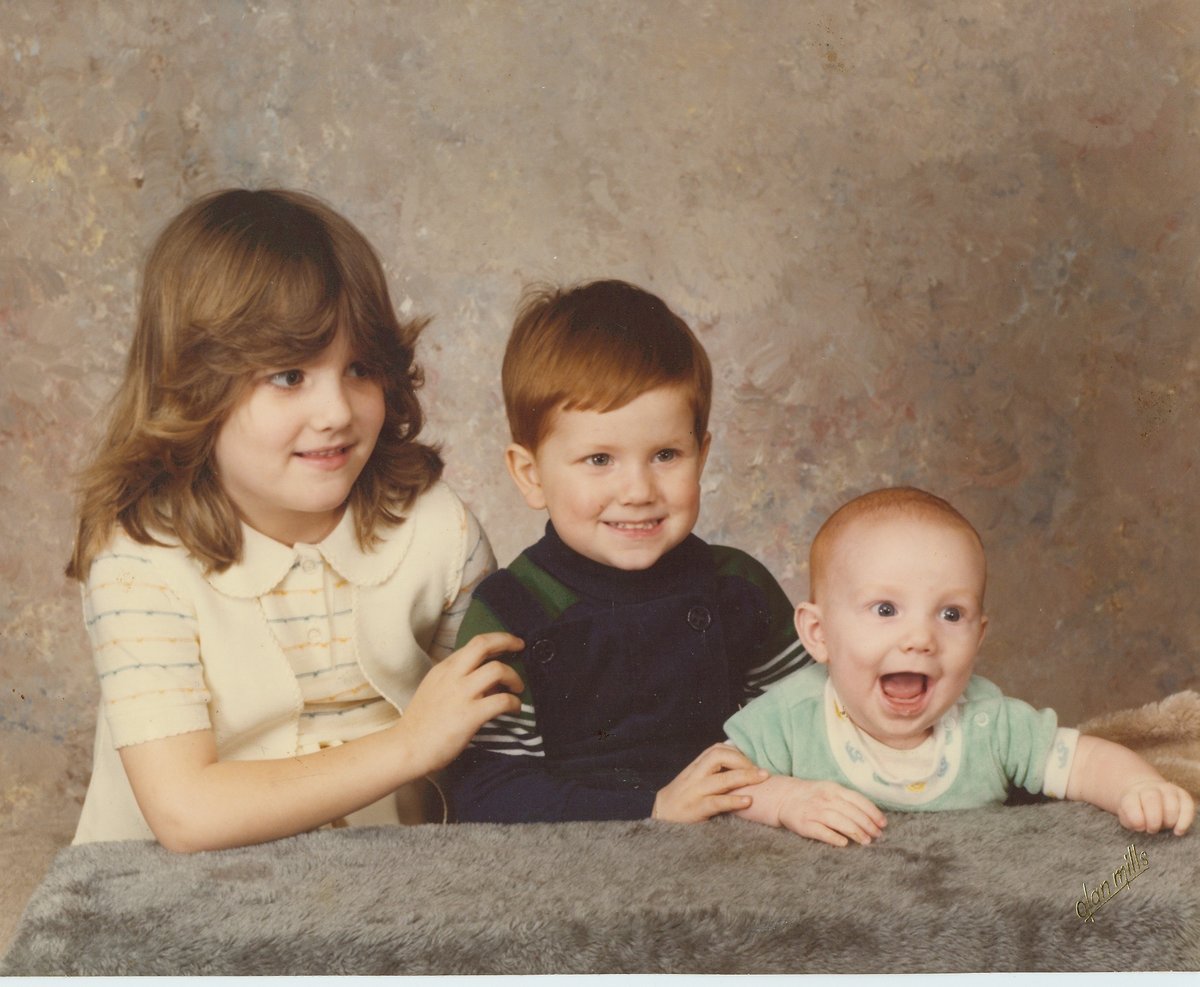
My birthday is November 3, 1979. This means that Election Day 2020 in the United States was also my 41st birthday. It was a very strange birthday. But I believe that anyone born in the first week of November who lives and/or votes in this country often finds themselves celebrating strange birthdays. Their memories and experiences of those days are different, more vivid, and more hopelessly entwine the political, civic, and personal.
I was very nearly born on November 2nd. That was my mother’s 28th birthday. She went into labor at lunch with my aunt and my grandmother. She was enjoying time away from my older brother and sister (then two and five) and didn’t want to change her plans. When she got home, she was well into labor but didn’t tell my father. My godmother, whom my whole family calls my Aunt Joette but who is not, strictly speaking, my aunt, and her husband, my Uncle Mike (same deal) came over to visit.
Uncle Mike somehow picked up that my mother was having contractions, timed them in his head, and told her when it was time to go to the hospital. He also offered to watch my siblings while my father drove her there. He even cleaned and vacuumed the house, with my brother clinging to his leg. Aunt Joette, who was 26 but already had three children of her own, hopped in the back seat of my parents’ Thunderbird. My mom, now seriously uncomfortable, told my dad to punch it. He drove through Detroit at over 100 mph to Hutzel Hospital, where I would be born. My godmother, always terrified of expressways and fast driving, has never ridden in a car with my father since. My dad still says he has never made such good time downtown.
But once they got to the hospital, everything stopped. My parents say it was the first sign of how stubborn I could be. (Frankly, this trait is overdetermined in my family.) My mother was in labor for more than 24 hours. Her doctors prepared for an emergency C-section before I arrived, about an hour and a half before the end of November 3. Since 1979 is an odd-numbered year, there wasn’t a federal election that week. But it would have been a good Election Day story if there had been one.
My mother’s father’s birthday was October 29th. In Detroit, October 30th is Devil’s Night. October 31st is Halloween. November 1st is All Saints’ Day and Dia de los Muertos; this holiday is a pretty big deal in southwest Detroit’s Mexicantown, where Uncle Mike, Aunt Joette, and my cousins Rachel, Nikki, and Miguel went to church at Holy Redeemer.
November 1st is also my mother’s brother’s birthday. My Uncle Chris is exactly fourteen years younger than my mother and fourteen years older than me. He turned 30 two days before I turned 16, and called my mother the day in between, and since my mom wasn’t home, he and I talked for about half an hour. With leap days included, he is just one day closer in age to my mother than he is to me. My mother’s birthday (and All Souls’ Day) is November 2nd, and mine is November 3rd. It’s a lot of birthdays and holidays in just a few days. My parents’ wedding anniversary is February 5th, which explains why I was born nine months later; the others in my family can plausibly be blamed on cold Michigan nights. This has always made the week of Election Day a pretty big deal in our family.

The first President elected in my lifetime was Ronald Reagan, on November 4, 1980. I don’t remember this very well, but I have seen pictures of my first birthday party the day before. My parents, like a surprisingly large number of Americans, both voted for independent candidate John Anderson, supposedly moved that he might be driven to bankruptcy by his campaign debts if he didn’t receive enough of the vote. Either they’re misremembering or are suckers, because in September, Anderson had already qualified for matching funds. Anyways, they both worked multiple jobs and had three small children, and ready access to reliable political information was not very good 40 years ago either.
I remember Reagan as President, but do not especially remember his reelection on November 6, 1984. I do remember my 5th birthday party extremely well. It was at McDonald’s, and my friends from kindergarten Andrew and Norman were invited. Ronald McDonald was there, I ate at least six Chicken McNuggets (which I still love), and Andrew gave me the He-Man action figure Jitsu, a bad guy with a golden hand that did a karate chop. He was kind of an evil knockoff of Fisto. Another of my uncles also gave me a copy of Jitsu, and I was excited about returning it and picking out a different He-Man character, but my younger brother took the second Jitsu out of its box, so we had two Jitsus, which is at least one too many. My brother was only three, but I was very upset with him.
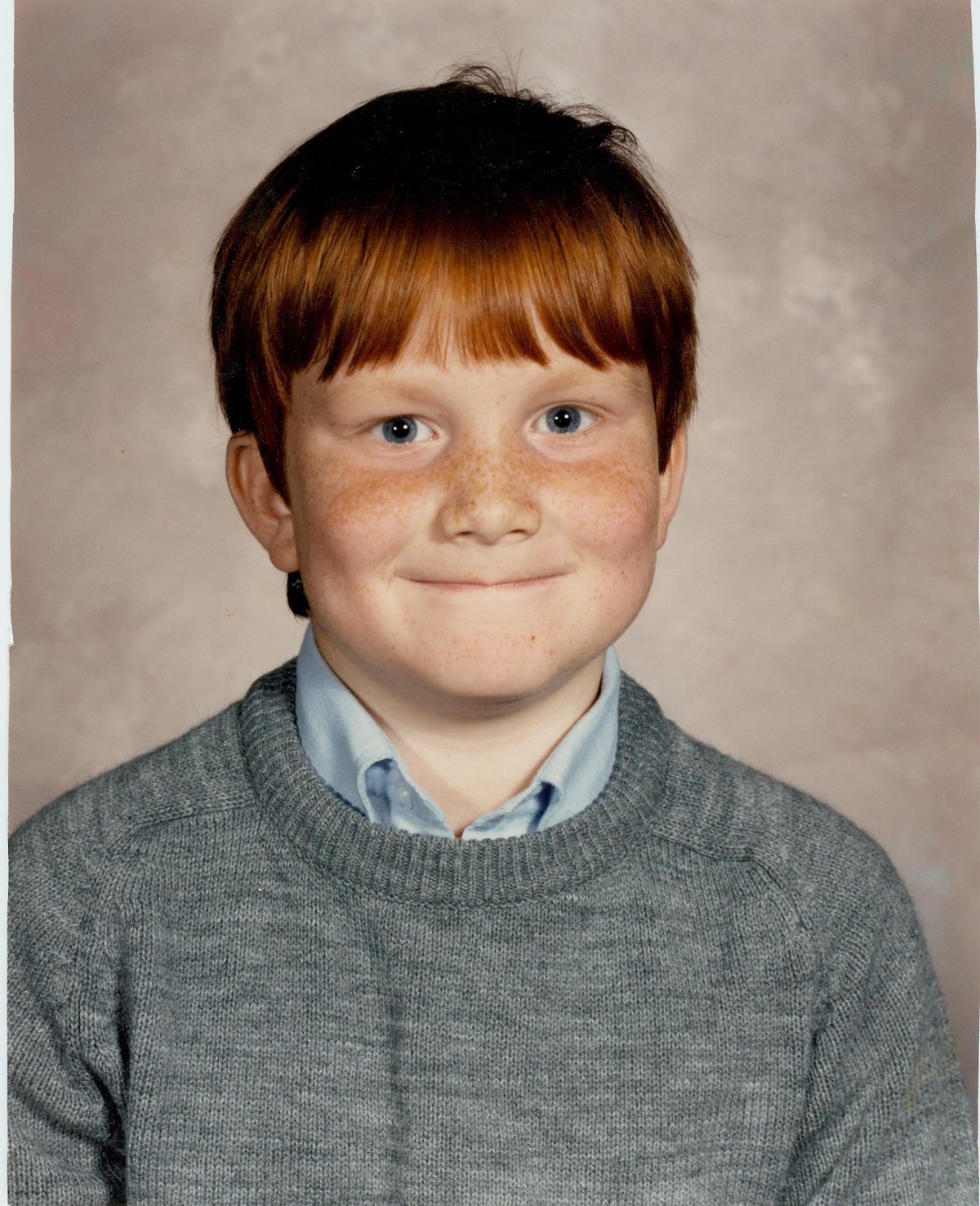
In 1988, my mom and I were pulling for Jesse Jackson, and both of us were pissed off when he didn’t win the nomination. (I’m still mad about this, actually.) This is when I start to remember Phil Hartman’s Ronald Reagan, Dana Carvey’s George H.W. Bush, and Jon Lovitz’s undersung Michael Dukakis (“I can’t believe I’m losing to this guy”).
My parents were not around very much—my sister is really the one who raised me while the two of them worked, and I’ve always thought of her as an equal parent as well as a beloved sibling—but they indulged my watching late night television and asking questions about the conventions at a young age. George H.W. Bush was elected on November 8th. (See, it’s not really always the first Tuesday in November, because for whatever reason, November 1st doesn’t count.)
Bill Clinton was elected President on November 3, 1992, my thirteenth birthday. In my junior high’s mock election, held the day before, Ross Perot won in a landslide. (We’d moved to the suburbs by this point.) Why were mostly-white suburban tweens entranced by Perot, who had simply nothing in his history or character to appeal to them, besides perhaps a funny voice? Some of it felt like a collective prank, a joke on the fact that the school was pretending to let us decide something we actually had no choice about: “Let’s all vote for Perot, and see what happens.”
I think some people were moved by the idea that something, anything unexpected might happen. It’s like why little kids are fascinated by dinosaurs: here are these creatures, older and bigger than your parents, older and bigger than anything, who once ruled the world. They all died, and anything, no matter how powerful or seemingly inevitable, can die again and be replaced by something new. I don’t know; maybe that was why my parents, still in their late twenties, wanted to vote for Anderson. Maybe that was part of why so many of my friends in college voted for Ralph Nader. Longing for change becomes something more than rational when so many external things determine your life.
Anyways, Bill Clinton was a deeply flawed President and remains a deeply flawed human being. Still, given the choices, I’m happy with how it actually turned out.
November 3rd was also the day of my last junior high football game. I was a starting defensive tackle, and our team was undefeated. So were our cross-town rivals at Wilkinson. They ran all over us that day: our defense, which had shut out all but one team we played and gone games without giving up any yards, could not stop Jason Byrd, a big, fast, 14-year-old athlete most of us knew from little league baseball. He died in 1997.

In 2000, I turned 21. Four days later, I voted for the first time. I did not vote in the 1998 midterms, even though Michigan’s governor was on the ballot, because my college town made it difficult for students to register to vote, and because, having just turned 19, I briefly did not believe electoral politics could create genuine change. I was also lazy, and foolish, and preoccupied with many other things.
But by 2000, I’d had a change of heart, and voted for Al Gore. I now think Gore would have been a better President than I believed then, partly because of the incredibly guarded, talking-out-both-sides-of-his-mouth campaign that he ran, but also because I did not foresee the disaster of the Bush years. I thought things would carry on mostly like they had, and that Bush, while dim and disengaged, would be a relatively benign conservative like I thought his father had been. I also thought he wouldn’t win anyways. I was a real putz. I had studied so much history but had no idea of what history had in store for us.
That year, my senior year in college, I lived in a big co-op house with fourteen other people. The house was right around the corner from my favorite bar, where I’d rung in my 21st birthday at midnight. We all watched the election results on CBS—I don’t know who chose that network, but Dan Rather had a lot of homespun idioms he used to introduce all the tosses and turns.
After the news came in that Florida had been called for Gore, then moved to toss-up, then called for Bush, then nobody was sure, my worst roommate, the one who let her dog shit all over the living room carpet, who installed her own private air conditioner even though we all split the utility bills, who everyone hated and nobody could figure out how she’d moved into the house or how to get her to leave, was openly celebrating a Bush win and taunting the rest of us (pretty even split Gore/Nader). I had one thought: I need a drink.
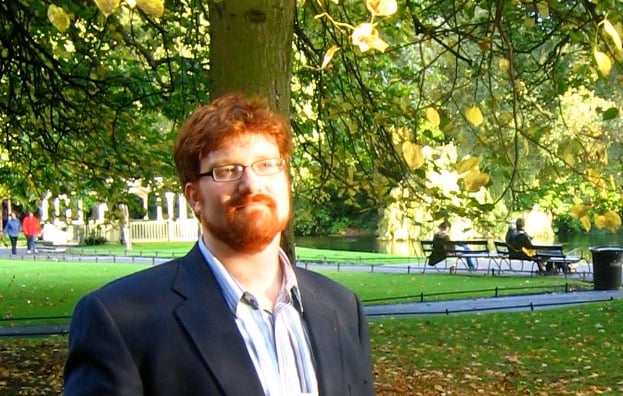
Bush won again, defeating John Kerry after Election Day on November 2, 2004. For me, this was the biggest gut-punch election of my life. I followed it closely, I watched all the debates, I participated in antiwar, anti-Bush, and anti-Cheney demonstrations, and met up with other young people involved in politics in Philadelphia, where I’d moved in 2002. I had thought Gore would win, but was convinced Kerry would—even after the midterm losses in 2002, even after the bombs fell on Iraq the day after my first son was born.
The next day, my 25th birthday, I walked around the city in a haze. I had to get groceries. The new Trader Joe’s on Market St had opened, right across the street from Center City’s small but lively porno district. I talked to my parents and each of my siblings on the phone, but I don’t remember what any of us said. Ohio was close, and there would be recounts, but it was over. Maybe Kerry would have been a good President, maybe he wouldn’t have, but at that moment, every possibility felt foreclosed upon. This is what they want, I thought. It wasn’t for the first time and certainly would not be the last.
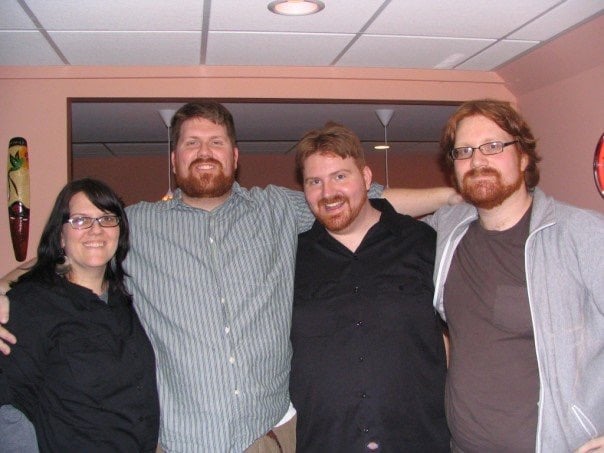
For years, I thought Barack Obama was elected on my birthday in 2008. I even told people in the run-up to the 2020 election, just weeks ago, no, it’s OK, it’s actually good luck: Barack Obama won on my birthday. It’s not true. He was elected on Tuesday, November 4th, the day after.
But those few days all feel like one day, in the best sense. Now, my younger son had just turned one year old in September, had been walking (for some value of “walking”) since August, and his mother and I hadn’t properly slept yet. On November 3rd, my friends Matt Thompson and Robin Sloan celebrated the fifth anniversary of their blog Snarkmarket by asking me to join them as the site’s third author. I was scrambling to finish my doctoral dissertation in comparative literature, and to send out applications for Assistant Professor and Visiting Fellow jobs that were rapidly disappearing thanks to the economic collapse. (More jobs I applied to cancelled their searches than gave me outright Nos.)
It was total disaster. And yet somehow, the best thing had happened. Obama was the only Presidential candidate I’d supported in the primary who’d ever made it to the general election (that’s still true, by the way). He was the first Presidential candidate I’d voted for who’d won, and I had a young, multiracial family living in the birthplace of the Declaration of Independence who were counting on him. Health care for everyone, an end to the war in Iraq, real progress for Black and Latinx (we didn’t use the X then, but I will now) and Middle Eastern and South and Central Asian people seemed imminent. I was now 29, and even though I professed to know better, to have made myself properly jaded, properly paranoid, properly realistic about the limits of elected officials, the military, corporations, and the American people… I found myself quite carried away, like so many others. Meanwhile, the slaughterhouse continued its work.

By November 2012, I was separated. I was living in Manhattan’s Hell’s Kitchen, but still registered to vote in Philadelphia. I had completely bounced out of academia, but somehow wound up with a series of very good jobs writing for technology magazines and websites. My son and his mom had just moved from Philadelphia to Atlanta after Philly’s public schools fell apart, making it much harder for me to take the train to see them.
My 33rd birthday was nevertheless my favorite ever. I was visiting Washington, DC for a few days, and all my friends in the area gathered to have brunch. Some of them knew each other, and some of them didn’t. We swapped stories about our “formative nerd texts,” the book that shaped our obsessions at an early age. (My answer: Calvin and Hobbes.) I had a crush on someone again, one of the first since my wife, and I didn’t know what to do with it. On the way back to New York, I stopped in Philadelphia to vote for Barack Obama again. (He won.) The city I’d lived in for a decade began to feel less and less like home. When I finally got from Penn Station to my apartment, I felt twin waves of longing and relief.
I turned 37 on November 3, 2016. My mother had just turned 65. My uncle, whom I remember as eternally 30, turned 51. By then, all of my grandparents had died. I had moved back in with my parents in metro Detroit the year before, partly to help my parents after my father’s heart attack, and partly because I had no place else to go.
I did not want to celebrate my birthday. I did not want to see or be seen by anyone. I closed off my wall on Facebook well before November. I stopped posting on Twitter a month before Election Day. Even though all the polls and polling averages, which had been so successful in 2008 and 2012 by controlling for known problems, had predicted until shortly before the end that Hillary Clinton would likely sail to an easy victory, I could feel what was coming.
I felt it in the part of my brain that can recognize a rattlesnake in the grass. There was nothing statistical about it at all, nothing deductive, just pure anticipation. Certain other primates have a word that means “snake,” and everyone in their band knows what it means. When they hear that word, the monkeys run for the trees. My brain was screaming that word, and it was running for the trees.
I thought, I will vote. And if she wins and he loses, then I will have helped stop this. And then I can kill myself.
Of course, it didn’t work out that way.
![]()
This Election Day and my 41st birthday have been even more unusual. It was my first birthday without my sister, Kelly. She had also been living with my parents after many years in New York, and died suddenly in April from a pulmonary embolism caused by COVID-19. My sister Kelly was 45 years old.
She would have been so good at figuring out how to celebrate my birthday and my mom’s, to keep us all safe and still have fun. She would have been so happy to vote to turn Michigan blue again. She would have had my nieces and nephews rolling with laughter at the funeral she didn’t have. She was my parent, and she was my sister. And she had a whole life to live that had nothing to do with me, but still shared with me, that she would tell me about on long telephone calls and late-night talks. And if she loved you, family or friend, she loved every part of you: she loved your parents and partners and children. She was the only person in my family who could befriend every generation, who could tell the third cousins apart, who knew what your second cousins’ kids wanted for Christmas without having to ask.
I feel like I lost all three people she was: sister, parent, protagonist. I still have so much I want to ask her about. I think I know, but I will never know.
We couldn’t celebrate my or my mother’s birthday with my brothers and their families, so my mother, my father, and I tried to make an even bigger celebration ourselves. Her birthday bled into mine, as it always does. We bought a Grand Traverse Baking Company cherry crumb pie, which was delicious. We had all already dropped off our ballots in October, so on Election Day (my birthday), we ordered carry-out from my favorite Lebanese restaurant. I bought a bottle of Jameson Irish whiskey, but didn’t drink any of it. I was in a good mood all night (the pie definitely helped), even as Michigan and Pennsylvania remained uncounted, as Georgia remained uncertain, as the blue mirage turned into a red mirage and back again.
Even now, although nearly all the votes have been counted (and Georgia’s, my son’s adopted home state, have been counted twice), Election Day is somehow not yet over. We knew it would be Election Week; few of us knew it would be Election Month.
Yet that means somehow my birthday is not yet over; it has metastasized to become all of Scorpio season, perhaps to Thanksgiving and after. And that means I am still only on the verge of turning 41, still 40, still waiting for the clock to turn over to start this next part of my life, a second half if I am lucky, a final third if everything goes chalk. I wasn’t born until late in the night on November 3, 1979, and I proved even before I was here that I can wait a very long time.
Still, I would like this to end, and end properly, even if I have to march on the state house in Michigan’s capitol building with the family I have left to see it out. Everyone is dying again; they have never stopped dying, and I would like to end that too.
I have no fantasies about Joe Biden or Kamala Harris. I don’t see them as avatars of hope like I saw Barack Obama, or as neoliberal schemers determined to betray their base. But I cannot survive (too many of us cannot survive) the petty fascist death cult of the Republican party under Trump. It has been building to this for generations, but now achieved its worst form yet. I will use every tool at my disposal, including the Democratic party, to crush them and drive them from power, like St. Patrick did Ireland’s snakes in legend.
They let New Orleans drown; they poisoned Flint; they let the police and bigots fashioning themselves as police murder Black people throughout the country, and then said it was the victims’ fault. They let my sister die and called it a rounding error. They have always been my enemies, ever since I was a little boy watching Ronald Reagan on television and realized what he was, even though I didn’t know the words for it. This was a man who would let us all die and (if he said anything at all) call our deaths noble and brave and necessary, if it would suit his vision of his own power, and perhaps enrich people I would never know.
Snake. The word I was looking for, that I already knew at four years old, was snake.
My father is terrified of snakes: he says that this is because in Ireland, where his parents were born, they have none. Snake is also what my mother’s people, the Ojibwe or Lake Superior Chippewa, called the Dakota and Lakota peoples when they fought them in what’s now Wisconsin: Sioux is a Chippewa word. (Literally, nadouessioux, or more properly natowessiwak, means “little snakes.”)
I know that if we want elections worth the name in 2022 or 2024 or any year afterwards, we have to win. The GOP, despite their hold on state legislatures, the courts, and at worst a 50/50 split in the US Senate, are fighting like they will never win a fairly counted, fairly administered, unsuppressed election again. And they might be right. But Democrats have to fight too. For once, Democrats have to forget that they’ve won and continue to fight.
I would like back everything that I have lost. But until the end of time and the return of the Messiah (and yes, I do mean Gritty), none of us can ever have that. All we can look forward to are more birthdays, more yahrzeits, and—I hope—more Election Days.
Maybe they will even become a holiday. Wouldn’t that be beautiful?
Tomorrow’s Special Guest…
Hey all. I’m taking the day off tomorrow (Friday) to take care of a few things I’ve been neglecting in my life recently (laundry, tidying, showering, maybe even email). But I am pleased to tell you that Mr. Tim Carmody will be covering for me in his typically fine fashion. Tim has been a part of this website for many years now and I’m so glad to welcome him back. He’ll be helming the @kottke Twitter account tomorrow as well, so pop over there if you want to say hello, offer feedback, etc. I’ll be back next week, hopefully with clean clothes.
This Village’s Adorable Christmas Lights Are Designed by Kids
In the Scottish village of Newburgh, the Christmas lights hung up around town were designed from drawings done by local schoolchildren. Poppy McKenzie Smith shared some of the displays on Twitter.


This is the best, way better than any professional display. The kids must feel so great seeing their handiwork lit up around town like this.
The Winners of the 2020 Weather Photographer of the Year Competition
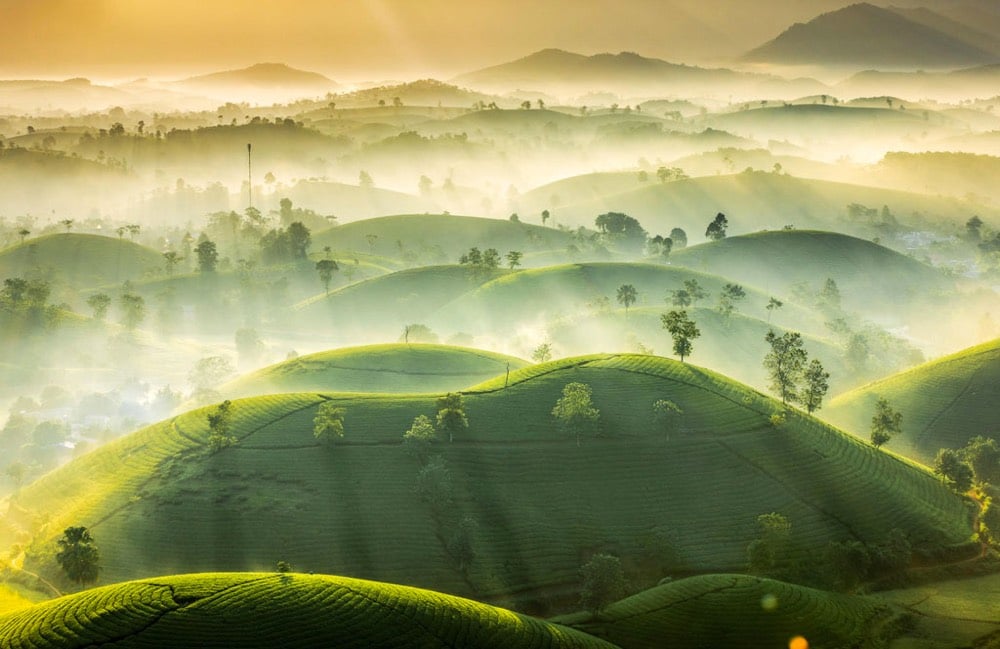


The Royal Meteorological Society has announced the winners and runners-up in the 2020 Weather Photographer of the Year competition. I shared some of my favorites above, but somehow none of the cloud pics made the cut? Am I feeling alright? *feels forehead* Ok, just one — I can’t resist cumulonimbus mammatus:
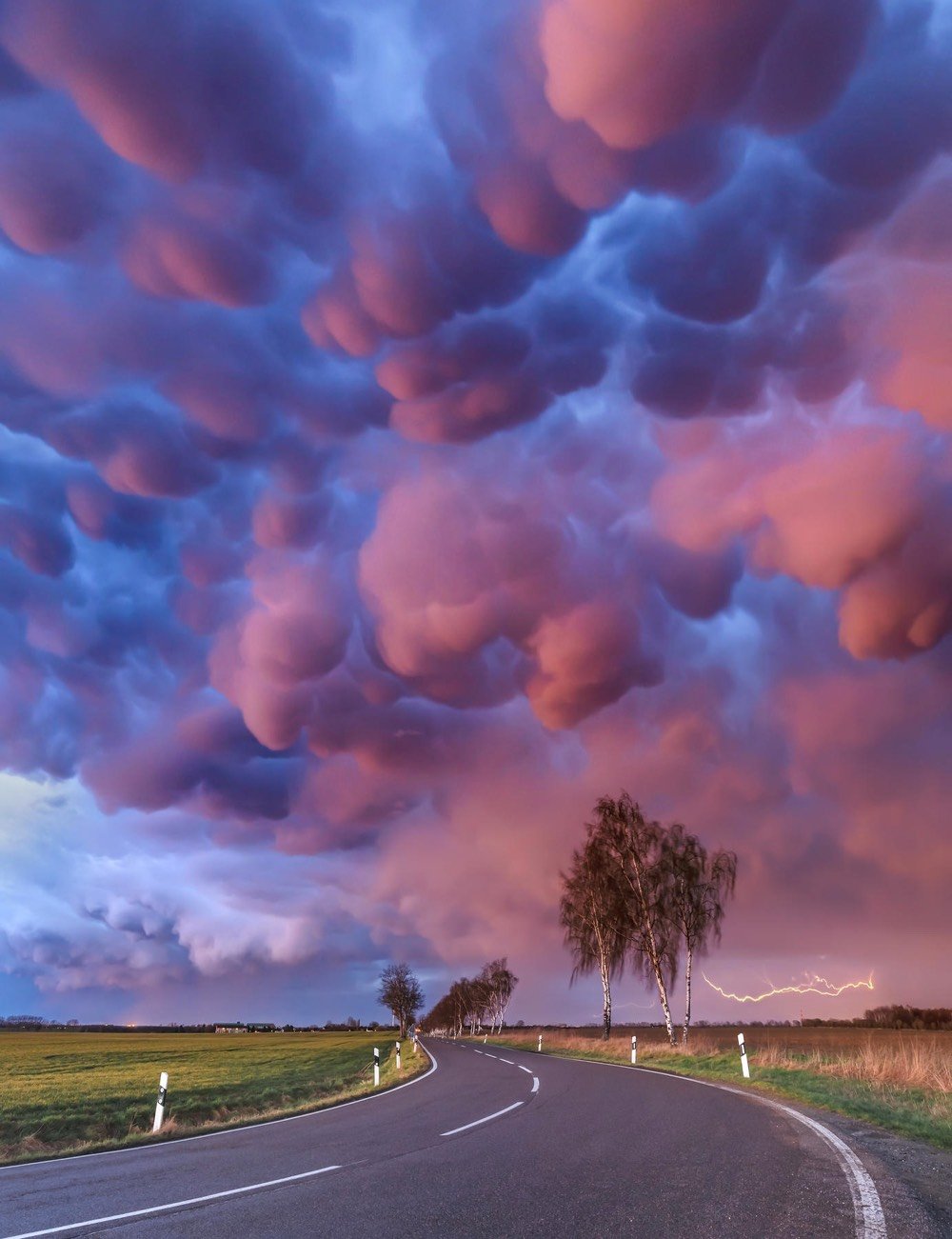
Photos by (top to bottom) Vu Trung Huan, Alexey Trofimov, Andrew McCaren, and Boris Jordan. (via moss & fog)
A Secret to Vermont’s Pandemic Success
For Vox, Julia Belluz takes a look at the approach that’s made Vermont more successful than most other US states in combatting Covid-19. The big thing? State officials recognized that those most at risk needed more support.
There’s a fatal flaw embedded in the basic Covid-19 test, trace, and isolate trifecta used around the world: It doesn’t account for the fact that the coronavirus is not an equal-opportunity pathogen. The people who are most likely to be tested, and to have the easiest time quarantining or isolating, are also the least likely to get sick and die from the virus.
From the United Kingdom to Sweden to Canada, we have evidence that the virus preys on people employed in “essential service” jobs (bus drivers, nurses, factory workers), which don’t allow for telecommuting or paid sick leave; people in low-income neighborhoods; and people in “congregate housing” like shelters, prisons, and retirement homes.
People of color tend to be overrepresented in these groups — but there’s no biological reason they’re more likely to get sick and die from the virus. Simply put: They tend to work jobs that bring them outside the home and into close contact with other people, live in crowded environments ideal for coronavirus contagion, or both.
The state then directed efforts, resources, and money to nursing homes, the unhoused, prisons, and essential workers to make it easier for those folks to stay safe.
I also thought this bit was really interesting:
There’s a simple adage in public health: “Never do a test without offering something in exchange,” said Johns Hopkins’s Stefan Baral. So when a patient gets tested for HIV, for example, they’re offered treatment, support, or contact tracing. “We’re not just doing the testing to get information but also providing a clear service,” Baral added, and potentially preventing that person from spreading the virus any further. “This is basic public health.”
With Covid-19, the US has failed at basic public health. Across the country, people have been asked to get tested without anything offered in exchange.
“If we are asking people to stay home and not work, we have to make sure society is supporting them,” Baral said. “An equitable program would support people to do the right thing.”
“Never do a test without offering something in exchange.” To the extent that federal and state governments have been asking to people to stay home, get tested, and wear a mask, many of those same governments have been unwilling or unable to provide people with much in return for doing so. And so, here we are months into this, paying for that inaction with 250,000 lives.
Update: How NYC does “never do a test without offering something in exchange”:
You can access a free hotel room to safely isolate from your family, which include meals, Rx delivery, free wi-fi, medical staff on site, and transportation to and from hotel and medical appointments.
(via @agoX)
Blade Runner Soundtrack Remastered into a Feature-Length Soundscape
I don’t think it’s much of a stretch to argue that much of the enduring success of Blade Runner comes down to how well the potent combination of the film’s score, created by electronic composer Vangelis, and the visuals instantly evoke, even in 2020, the future. Ok, a dystopian neo-noir future, but the future nonetheless. A YouTuber has reworked that score, along with ambient sounds and dialogue from the film, into a feature-length soundscape that, as Colin Marshall put it at Open Culture, “feels a great deal like watching Blade Runner without actually watching Blade Runner”. I think I’ll be listening to this as I work today. (via open culture)
Winning Shots from the 2020 International Landscape Photographer of the Year Awards


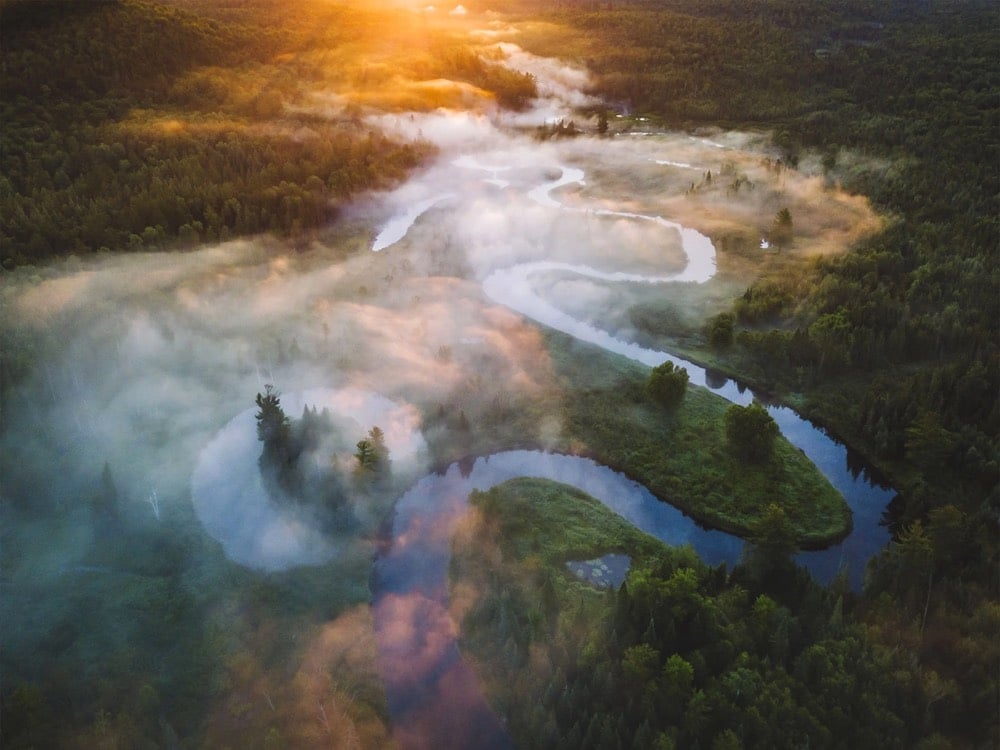
The International Landscape Photographer of the Year Awards have announced their results for this year and you can see some of the winning photographs at In Focus. Photos by (top to bottom) Shashank Khanna, Vikki Macleod, and Nikhil Nagane.
“T-shirt? Towel? Some experts say it’s time to get beyond states’ anything-goes approach to masks.” Yes. Enough of the bandanas and single-ply gaiters.
Was This Famous War Photo Staged?
In 2007, Errol Morris wrote a three-part series for the NY Times about a pair of photos taken by Roger Fenton of the Crimean War in 1855. Taken from the same position on the same day, one of the photographs shows cannonballs scattered on a road while in the other photo, the road is clear of cannonballs. Which one, Morris wondered, was taken first and why?
I spent a considerable amount of time looking at the two photographs and thinking about the two sentences. Sontag, of course, does not claim that Fenton altered either photograph after taking them — only that he altered or “staged” the second photograph by altering the landscape that was photographed. This much seems clear. But how did Sontag know that Fenton altered the landscape or, for that matter, “oversaw the scattering of the cannonballs on the road itself?”
His three posts about these photographs are a fascinating exposition on truth and evidence — I posted about them back when he wrote them, saying of part one that “this might be the best blog post I’ve ever read” — and I recommend you read them, but the next best thing is watching the video above in which Vox Darkroom’s Coleman Lowndes talks with Morris about the mystery of the photos and how he arrived at a conclusion.
What Happens When You Spend Weeks, Months, or Even Years in Solitary Confinement
This video interview with two former inmates (Five Mualimm-Ak and Terrence Slater) about their experiences in solitary confinement is, well, I was going to says “sobering” but it’s not sobering. It’s fucking infuriating and upsetting. Just to pick one moment, here’s Mualimm-Ak’s answer to “How do you maintain a sense of who you are?”:
You don’t. You live off of your memories because you have nothing else to accumulate to move forward. And then you end up having this short-term memory disorder which is a part of you the consequences of being in solitary where you can’t keep one train of thought for too long. And then you’re dropped off in 42nd Street-Times Square, the biggest tourist spot in the world, with 20 million commuters. It’s a sensory overload.
As Atul Gawande wrote in the New Yorker in 2003, solitary confinement is legalized torture by the state. Here’s more from a Psychology Today article on how long-term solitary can change your perception of the world:
Being confined in a 6x9-foot cell for almost 30 years, with very limited contact with other humans or physical exercise, surely has consequences on one’s overall health, including the brain. King knew that solitary confinement was changing the way his brain worked. When he finally left his cell, he realized he had trouble recognizing faces and had to retrain his eyes to learn what a face was like. His sense of direction was also messed up, and he was unable to follow a simple route in the city by himself. It is as if his brain had erased all those capabilities that were no longer necessary for survival in a cell no bigger than the back of a pick-up truck.
A couple of things from the video that merit your attention. The first is Hell Is a Very Small Place, a book of stories by people who are now or have been in solitary confinement. And second, Mualimm-Ak started an organization called Incarcerated Nation Network “an abolition alliance network dedicated to transforming the prison industrial complex & ending torture” — join me in sending a donation to them? (via open culture)
The Best Maps & Charts from the 2020 Election
From Stamen’s lead cartographer Alan McConchie, an excellent review of the charts and maps that best communicated vital information about the 2020 election.
After the first night of election results was over, and most of the state races had been called, we settled in for several more days of vote counting in a few key states. Dynamic “choose your own adventure” maps and scenario modeling tools became much less useful, and the landscape of the remaining Electoral College outcomes could be explained better without a map or a chart at all. Simple infographics like this one from the BBC did an excellent job of telling the reader all they needed to know.
You should dig into the article for the commentary and analysis, but I did want to share a couple of my favorite maps/charts:
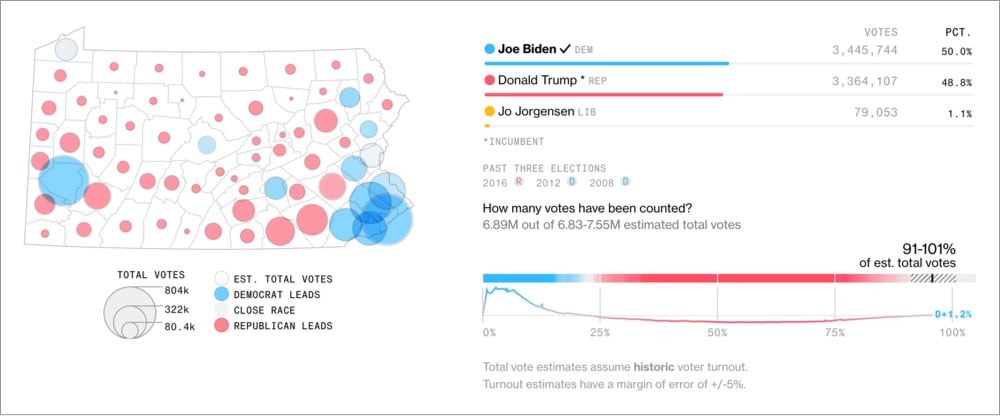
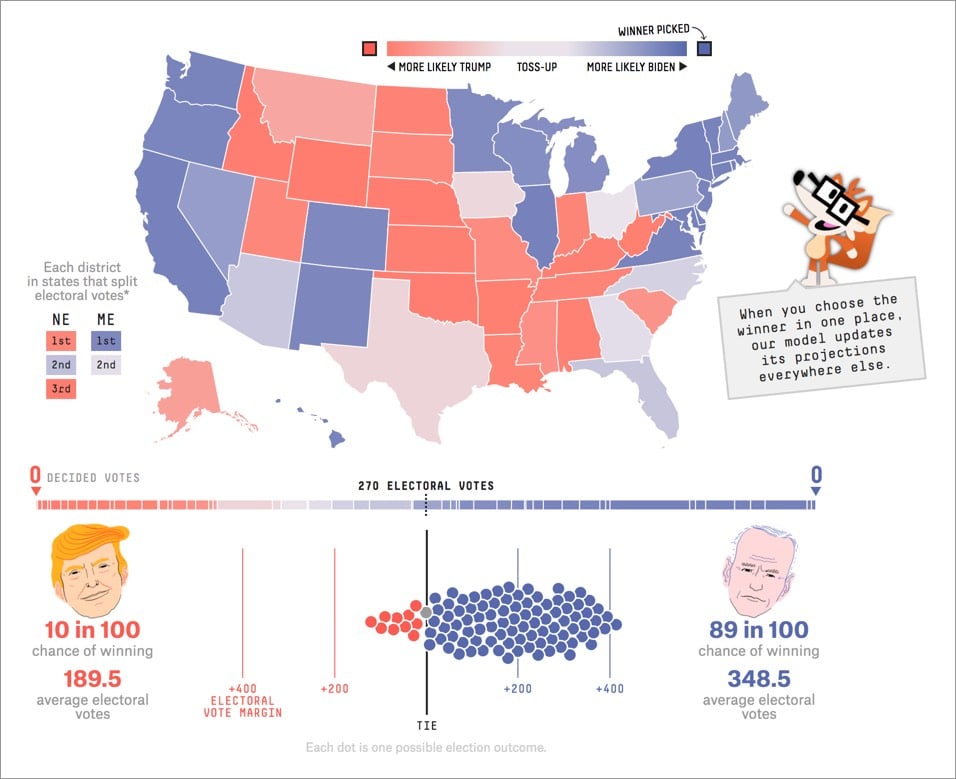

The graphs by John Harurum in that last image were especially useful for me in seeing how the counting trends were going.
Video of an anti-vaxxer gathering in Iowa last weekend shows huge indoor gathering, chanting Freedom!, no mask wearing, no distancing. Currently 51.7% of tested Iowans have Covid. Pure lunacy.
Pandemic Safety Rules
As I write this, it’s snowing outside here in Vermont and Covid-19 has finally gained a foothold in our little state. At the governor’s press conference yesterday, he and his pandemic response team announced that contact tracing done by the state showed that the rise in cases started as an outbreak in some hockey leagues. That initial outbreak wasn’t contained and subsequent non-essential, indoor, mask-less, multi-household gatherings and Halloween parties resulted in the very sharp rise we started to see here in the first week of November.
Scott explained that 71% of outbreaks reported from Oct. 1 to Nov. 13 were linked to “social events, parties and people hanging out at home or bars and clubs.” He added Vermont has not seen the virus spread widely at schools, restaurants or other businesses.
Dr. Mark Levine, the state health commissioner, said those parties came in a variety of sizes of parties — Halloween gatherings large and small, dinner parties, baby showers, “people in the high single numbers at a deer camp.”
In states with many infections, particularly in the Midwest, contact tracing is all but impossible, so it’s instructive to pay attention to Vermont’s example here: we’re doing the tracing and the tracers say the infections are coming from people gathering indoors across multiple households. Which is exactly what public health and medical experts have been urging people not to do for months now.
And that brings us to Thanksgiving. For The Atlantic, Rachel Gutman asked her colleagues who have been writing extensively about the pandemic for some of their top safety rules and guidelines and their number one was, say it with me:
My colleagues’ guidance boils down to this winter’s golden rule for interacting with anyone outside your immediate household: Don’t spend time indoors with other people.
Here it is again in a fun font, just to make sure you got it: 𝓓𝓸𝓷’𝓽 𝓼𝓹𝓮𝓷𝓭 𝓽𝓲𝓶𝓮 𝓲𝓷𝓭𝓸𝓸𝓻𝓼 𝔀𝓲𝓽𝓱 𝓸𝓽𝓱𝓮𝓻 𝓹𝓮𝓸𝓹𝓵𝓮.
Look, for some people spending time indoors with others is essential — jobs, education, etc. — but those who don’t have to, shouldn’t. And this goes for everywhere in the US because no states (aside from maybe Hawaii) are doing well right now — cases are either high, rising sharply, or both. Please please don’t gather in indoor, multi-household groups for Thanksgiving if you haven’t quarantined beforehand. In the US right now, about 1-in-55 people who get Covid-19 die from it. With rates already high around the country, if many people do Thanksgiving as usual, an already horrific and deadly situation could become much much worse.
Modelling the risk of aerosol transmission of Covid-19 during Thanksgiving dinner. Room size matters, outdoors is very low risk, “if superspreader present, everyone will be infected”, risk rises faster than group size, HEPA filters useful.
Apple reduces their App Store cut to 15% for businesses making less than $1 million/yr. Why not make this automatic and more progressive though?
More preliminary results from Pfizer’s Covid-19 vaccine: 95% effective after 170 accumulated infections. Moderna reported 94.5%. This is good news.
On the Authenticity of the Chess in The Queen’s Gambit
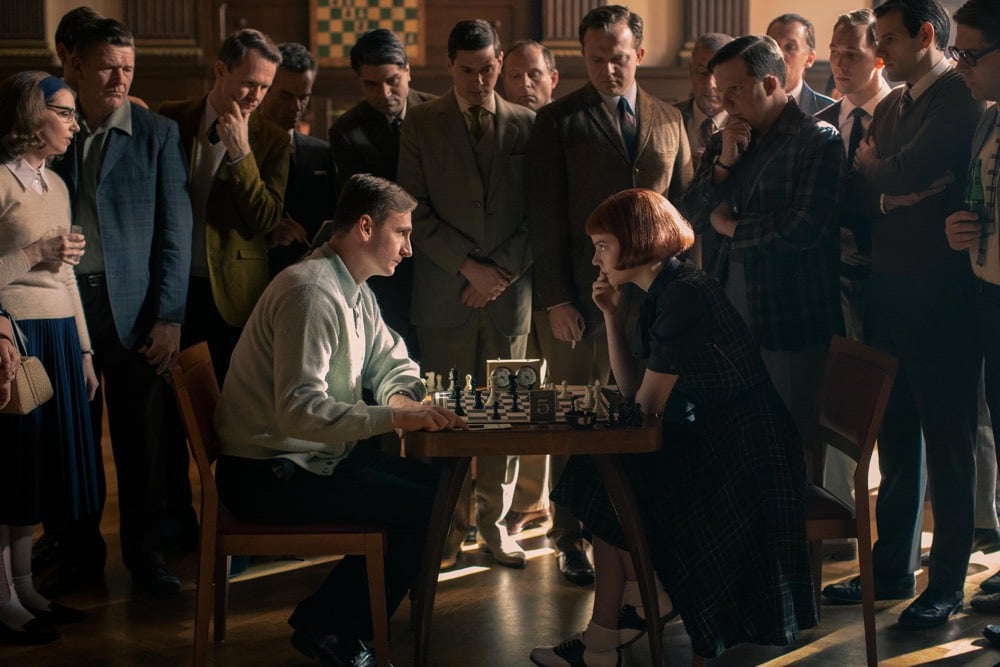
Like many of you, I watched and loved The Queen’s Gambit on Netflix (trailer). Part of the reason it’s so compelling is the care the show’s creators took in accurately portraying the chess players, games, and tournaments. Over the past few weeks, I’ve been reading articles by and interviews with chess experts on what the show got right and wrong. I’ll link to some of them below, but this interview with Garry Kasparov, one of the best chess players ever and an advisor to the show, is particularly worth reading. Here he talks about choosing a real game to be played as the final match in the series (spoilers):
Most of the games, it was not difficult, but the biggest challenge was the last game, because the last game is just, it’s a full game. And the problem is that the last game had to be played by the Queen’s Gambit. Of course I could pick up games from other openings, but it would be very much against the spirit of the book. How did I find a good game that will be played for 40 or so moves adjourned in a complicated situation? And then you have this very important element of Benny and his team calling from New York. It means the position had to be complicated. I found a few games and picked up one: Patrick Wolff against Vassily Ivanchuk, Biel Interzonal, 1993. Wolff sent me a note a couple of days after the show was released: “I recognize the game.” It was quite an obscure game. He said, “Garry, how on earth did you find it?” I said, “I had certain parameters, with the gambit, the number of pieces left, so basically, I ended up with 700 games.” It’s not perfect, because it’s not exactly as complicated as I want it, but it fit the book description: game adjourned, complicated position. And even with all the ruckus, he’s pushing the rook. The rook is trapped in the center. I preserved most of the game description and I think it helped, because that’s a climax, and the climax is something that people always recall.
The interview is interesting throughout. Here are some of the other articles I’ve read: former pro Linda Diaz, former top 10 player Judit Polgar (and others), former NY Times chess columnist Dylan Loeb McClain, chess pros Alexandra and Andrea Boetz, 2-time US champ Jennifer Shahade, and ChessBase editor Albert Silver.
Today Marks a Year of Covid-19
According to an unpublicized report by the Chinese government, the first documented case of Covid-19 was a 55-year-old person living in Hubei province on November 17, 2019. That makes today the first anniversary of the start of the Covid-19 pandemic. From that person (and possibly earlier or concurrent cases), the disease slowly and silently spread until it was determined to be due to a novel coronavirus.
They found that following the Nov. 17 case, about one to five new cases were reported every day and by Dec. 15, the total infections reached 27. Daily cases seem to have increased after that, with the case count reaching 60 by Dec. 20, the SCMP reported.
On Dec. 27, Dr. Zhang Jixian, head of the respiratory department at Hubei Provincial Hospital, reported to health officials in China that a novel coronavirus was causing the disease; by that day, it had infected more than 180 individuals. (Doctors may not have been aware of all of those cases at the time, but only identified those cases after going back over the records, the Morning Post reported.)
No one had any idea how much the world was going to change that day. What an awful, humbling, terrifying, ghoulish year.
Anonymous Obama Gets Some Ice Cream
Barack Obama’s A Promised Land comes out today and The Root’s Michael Harriot has a brief interview with Obama. The rest of the interview is meatier, but I like Harriott’s last question:
Q: You are a former president and you are unquestionably the predominant role model for a generation of Black people, both of which come with a certain amount of public scrutiny. But for one day, you get to be an anonymous, everyday American who can go anywhere you want and do anything. Describe that day.
A: You know, honestly, I’d just take a walk. Go to the grocery store. Go out to dinner with Michelle. Maybe get some ice cream. Around my second or third year in office, I’d have this recurring dream, maybe once every six months, where I’m walking down the street and head into a coffee shop or a bar or something and nobody recognizes me. It was great!
You can read the rest of his answer, including his thoughts on “the tyranny of selfie”. I watched the Pete Souza documentary The Way I See It the other day1 and the wildest scenes were the ones showing a young Obama on the Senate campaign trail just walking around with no one noticing or bothering him. He must miss those days for sure. But I bet it’s also fun to be able to get literally anyone you want on the phone in 30 seconds.
P.S. I haven’t read it myself yet, but I’ve heard from many folks that Jeffrey Goldberg’s lengthy conversation with Obama is worth checking out.
P.P.S. In their excellent 5-part series on Princess Diana, You’re Wrong About’s Michael Hobbes shared his theory that “fame is abuse” and I’ve been thinking about that in relation to every celebrity story I’ve read since.
Pro tip: in the US it’s streaming for free on Peacock, NBC’s new streaming service.↩
The COVID-19 Event Risk Assessment Planning Tool estimates how likely it is for a Covid-positive person to be at a gathering of X people. At a gathering of 15 people where I grew up in WI, there’s currently an 81% chance that someone there will have it.
Beyond parody…this is real Cosmo front page copy (about The Black Death!): “Dating Lessons from Pandemics Past – The 14th Century Called and It Wants Its Sex Spree Back”
The Swiss Cheese Covid-19 Defense
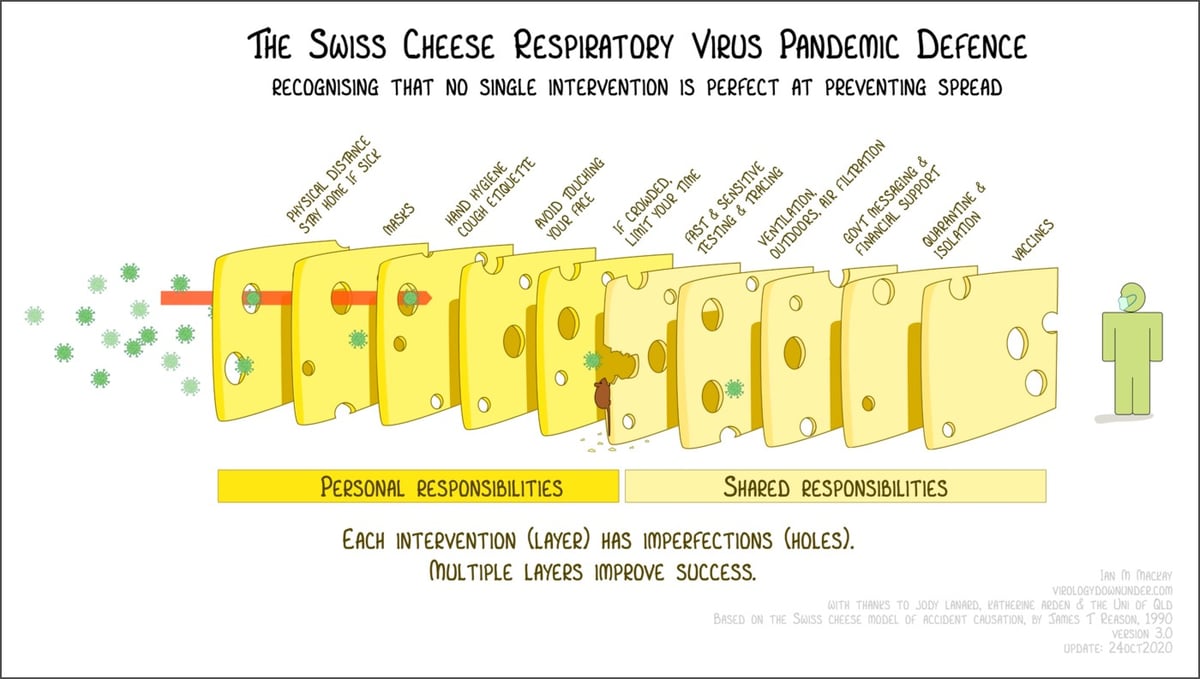
The Swiss cheese model of accident causation is a framework for thinking about how to layer security measures to minimize risk and prevent failure. The idea is that when several layers of interventions, despite their weaknesses, are properly stacked up between a hazard and a potentially bad outcome, they are able to cumulatively prevent that outcome because there’s no single point of failure. During the pandemic, health care workers and public health officials have been using the Swiss cheese model to visualize how various measures can work together to help keep people safe.
Virologist Dr. Ian Mackay has visualized the Swiss cheese Covid-19 defense in a wonderful way (pictured above). Each layer of cheese represents a personal or shared intervention — like mask wearing, limiting your time indoors w/ crowds, proper ventilation, quarantine, vaccines — and the holes are imperfections. Applied together, these imperfect measures work like a filter and can vastly improve chances of success.1 He even added a “misinformation mouse” chewing through one of the cheese slices to represent how deceptive information can weaken these defenses.
Mackay has released this graphic under a Creative Commons license (free to share and adapt w/ attribution) and is available in English, German, French, Spanish, Korean, and several other languages. (via @EricTopol)
It’s interesting that the Swiss cheese model is physically how masks work to stop aerosols and droplets — like layered filters and not sieves.↩
America’s healthcare workers, already strained and exhausted from months of continuous effort, are facing a “bigger and broader” third surge. “More people than ever are hospitalized with COVID-19. Health-care workers can’t go on like this.”
53 Whiskey Cocktails to Get You Through Winter. Only 53?! I don’t know if that’s going to be enough… (Pairs well with The 4000 Best Movies You Must Watch on Netflix Tonight!!!)
“It’s Time to Hunker Down”
Zeynep Tufekci says that a devastating third pandemic surge is upon us and that It’s Time to Hunker Down. She leads with the good news (vaccines, treatments, knowledge, testing capacity & quickness) but notes that with winter coming and a high baseline of cases from a summer not spent in preparation, now is the time to really knuckle down so that we can get to the finish line.
Whatever the causes, public-health experts knew a fall and winter wave was a high likelihood, and urged us to get ready.
But we did not.
The best way to prepare would have been to enter this phase with as few cases as possible. In exponential processes like epidemics, the baseline matters a great deal. Once the numbers are this large, it’s very easy for them to get much larger, very quickly — and they will. When we start with half a million confirmed cases a week, as we had in mid-October, it’s like a runaway train. Only a few weeks later, we are already at about 1 million cases a week, with no sign of slowing down.
Americans are reporting higher numbers of contacts compared with the spring, probably because of quarantine fatigue and confusing guidance. It’s hard to keep up a restricted life. But what we’re facing now isn’t forever.
It’s time to buckle up and lock ourselves down again, and to do so with fresh vigilance. Remember: We are barely nine or 10 months into this pandemic, and we have not experienced a full-blown fall or winter season. Everything that we may have done somewhat cautiously — and gotten away with — in summer may carry a higher risk now, because the conditions are different and the case baseline is much higher.
The Covid-19 Crystal Ball: Estimating Future Deaths from Today’s Reported Cases
On Friday, November 13, 170,792 new cases of Covid-19 were reported in the United States. About 3000 of those people will die from their disease on Dec 6 — one day of Covid deaths equal to the number of people who died on 9/11. It’s already baked in, it’s already happened. Here’s how we know.
The case fatality rate (or ratio) for a disease is the number of confirmed deaths divided by the number of confirmed cases. For Covid-19 in the United States, the overall case fatality rate (CFR) is 2.3%. That is, since the beginning of the pandemic, 2.3% of those who have tested positive for Covid-19 in the US have died. In India, it’s 1.5%, Germany is at 1.6%, Iran 5.5%, and in Mexico it’s a terrifying 9.8%.
A recent analysis by infectious disease researcher Trevor Bedford tells us two things related to the CFR.
1. Reported deaths from Covid-19 lag behind reported cases by 22 days. Some deaths are reported sooner and some later, but in general it’s a 22-day lag.1
2. The overall CFR in the US is 2.3% but if you use the 22-day lag to calculate what Bedford calls “a lag-adjusted case fatality rate”, it’s a pretty steady average of 1.8% since August. Here’s a graph:
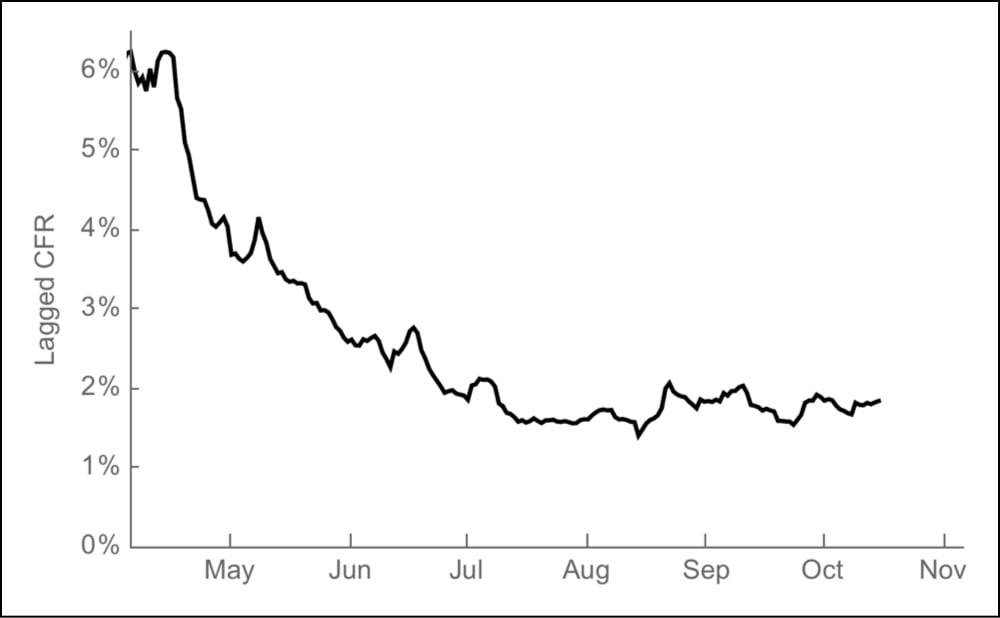
As you can see, in the early days of the pandemic, 4-6% of the cases ended in death and now that’s down to ~1.8%. That’s good news! The less good news is that the current case rate is high and rising quickly. Because of the lag in reported deaths, the rise in cases might not seem that alarming to some, even though those deaths will eventually happen. What Bedford’s analysis provides is a quick way to estimate the number of deaths that will occur in the future based on the number of cases today: just multiply the number of a day’s cases by 1.8% and you get an estimated number of people who will die 22 days later.2
For instance, as I said above, 170,792 cases were reported on Nov 13 — 1.8% is 3074 deaths to be reported on December 6. Cases have been over 100,000 per day for 11 days now: here are the estimated deaths from that time period:
| Date | Cases | Est. deaths (on date) |
|---|---|---|
| 2020-11-15 | 145,670 | 2622 (2020-12-08) |
| 2020-11-14 | 163,473 | 2943 (2020-12-07) |
| 2020-11-13 | 170,792 | 3074 (2020-12-06) |
| 2020-11-12 | 150,526 | 2709 (2020-12-05) |
| 2020-11-11 | 144,499 | 2601 (2020-12-04) |
| 2020-11-10 | 130,989 | 2358 (2020-12-03) |
| 2020-11-09 | 118,708 | 2137 (2020-12-02) |
| 2020-11-08 | 110,838 | 1995 (2020-12-01) |
| 2020-11-07 | 129,191 | 2325 (2020-11-30) |
| 2020-11-06 | 125,252 | 2255 (2020-11-29) |
| 2020-11-05 | 116,153 | 2091 (2020-11-28) |
| 2020-11-04 | 103,067 | 1855 (2020-11-27) |
| Totals | 1,609,158 | 28,965 |
Starting the day after Thanksgiving, a day traditionally called Black Friday, the 1.6 million positive cases reported in the past 12 days will result in 2-3000 deaths per day from then into the first week of December. Statistically speaking, these deaths have already occurred — as Bedford says, they are “baked in”. Assuming the lagged CFR stays at ~1.8% (it could increase due to an overtaxed medical system) and if the number of cases keeps rising, the daily death toll would get even worse. As daily case totals are reported, you can just do the math yourself:
number of cases × 0.018
200,000 cases in a day would be ~3600 deaths. 300,000 daily cases, a number that would have been inconceivable to imagine in May but is now within the realm of possibility, would result in 5400 deaths in a single day. Vaccines are coming, there is hope on the horizon. But make no mistake: this is an absolute unmitigated catastrophe for the United States.
Update: Over at The Atlantic, Alexis Madrigal and Whet Moser took a closer look at Bedford’s model, aided by Ryan Tibshirani’s analysis.
Tibshirani’s first finding was that the lag time between states was quite variable-and that the median lag time was 16 days, a lot shorter than the mean. Looking state by state, Tibshirani concluded, it seemed difficult to land on an exact number of days as the “right” lag “with any amount of confidence,” he told us. Because cases are rising quickly, a shorter lag time would mean a larger denominator of cases for recent days — and a lower current case-fatality rate, something like 1.4 percent. This could mean fewer overall people are dying.
But this approach does not change the most important prediction. The country will still cross the threshold of 2,000 deaths a day, and even more quickly than Bedford originally predicted. Cases were significantly higher 16 days ago than 22 days ago, so a shorter lag time means that those higher case numbers show up in the deaths data sooner. Even with a lower case-fatality rate, deaths climb quickly. Estimating this way, the country would hit an average of 2,000 deaths a day on November 30.
The other major finding in Tibshirani’s analysis is that the individual assumptions and parameters in a Bedford-style model don’t matter too much. You can swap in different CFRs and lag-time parameters, and the outputs are more consistent than you might expect. They are all bad news. And, looking retrospectively, Tibshirani found that a reasonable, Bedford-style lagged-CFR model would have generated more accurate national-death-count predictions than the CDC’s ensemble model since July.
Courtesy of Ed Yong, the lag between cases and hospitalizations is about 11 days. So the full ICUs and packed ERs were hearing about now are going to get so much worse in the next two weeks. And just think about the potential situation a month from now if cases keep rising at the rate they are now for two more weeks…↩
Just to stress again: this is only an estimate. The real reported deaths from a single day’s reported cases will be spread out over several days or weeks. And case reporting is much lower on Sundays and Mondays than on other days (fewer reports on weekends). Bedford accounted for this in his analysis by using 7-day averages.↩
Using techniques borrowed from sex-ed (to e.g. encourage condom use) to talk to people about mask wearing. “It feels strange to do this even if you don’t feel sick. That’s actually why it matters: if we do this, we get to keep…spending time together.”
Preliminary Results: Moderna Covid-19 Vaccine Is 94.5% Effective
Last Monday the world got some good news: an early review of the data showed that Pfizer’s Covid-19 vaccine was “more than 90% effective” in preventing the disease. The results pointed to other vaccines also being highly effective against the virus and this morning comes this news: Early Data Show Moderna’s Coronavirus Vaccine Is 94.5% Effective.
The drugmaker Moderna announced on Monday that its coronavirus vaccine was 94.5 percent effective, based on an early look at the results from its large, continuing study.
Researchers said the results were better than they had dared to imagine. But the vaccine will not be widely available for months, probably not until spring.
Despite the delivery timeline, this is such good news.
The companies’ products open the door to an entirely new way of creating vaccines — and creating them fast. Both use a synthetic version of coronavirus genetic material, called messenger RNA or mRNA, to program a person’s cells to churn out many copies of a fragment of the virus. That fragment sets off alarms in the immune system and stimulates it to attack, should the real virus try to invade. Although a number of vaccines using this technology are in development for other infections and cancers, none have yet been approved or marketed.
“The fact that two different vaccines made by two different companies with two different kinds of structures, in a new messenger RNA concept, both worked so effectively confirms the concept once and for all that this is a viable strategy not only for Covid but for future infectious disease threats,” said Dr. Barry R. Bloom, a professor of public health at Harvard.
Natalie E. Dean, a biostatistician at the University of Florida, said an important finding was that the vaccine appeared to prevent severe disease. Pfizer did not release information about disease severity when reporting its results.
Researchers say the positive results from Pfizer and Moderna bode well for other vaccines, because all of the candidates being tested aim at the same target - the so-called spike protein on the coronavirus that it uses to invade human cells.
It’s only a few more months — please please do what you can to stay safe and keep others safe (especially medical workers) until these vaccines can be rolled out.
A South Dakota ER nurse on her Covid-19 patients who refuse to believe Covid is real. “They call you names and ask why you have to wear all that ‘stuff’ because they don’t have COViD because it’s not real. Yes. This really happens.”
Virtual Sets Are Replacing Green Screens
The green screen is a staple of visual effects for movies and TV. You film actors in front of a green or blue screen and then use digital editing technology to replace the solid color with any background you’d like. But as Phil Edwards explains in this video, the effects teams for some movies and shows (like Disney’s The Mandalorian) have swapped green screens for virtual sets. In lieu of block colored backgrounds, the actors are surrounded by massive LED panels that display the background and background action so everything can be filmed in one go.
It’s a pretty cool technique. Among the benefits of such a system: you get the “natural” light from the LEDs falling on the actors and other objects in the scene, so you don’t need to add it in later digitally or use extra on-set lighting.
Unable to get together in person, two friends have been writing daily haikus to each other during the pandemic. Some lovely thoughts here on creativity, friendship, and happiness.
Fantastical Face Masks

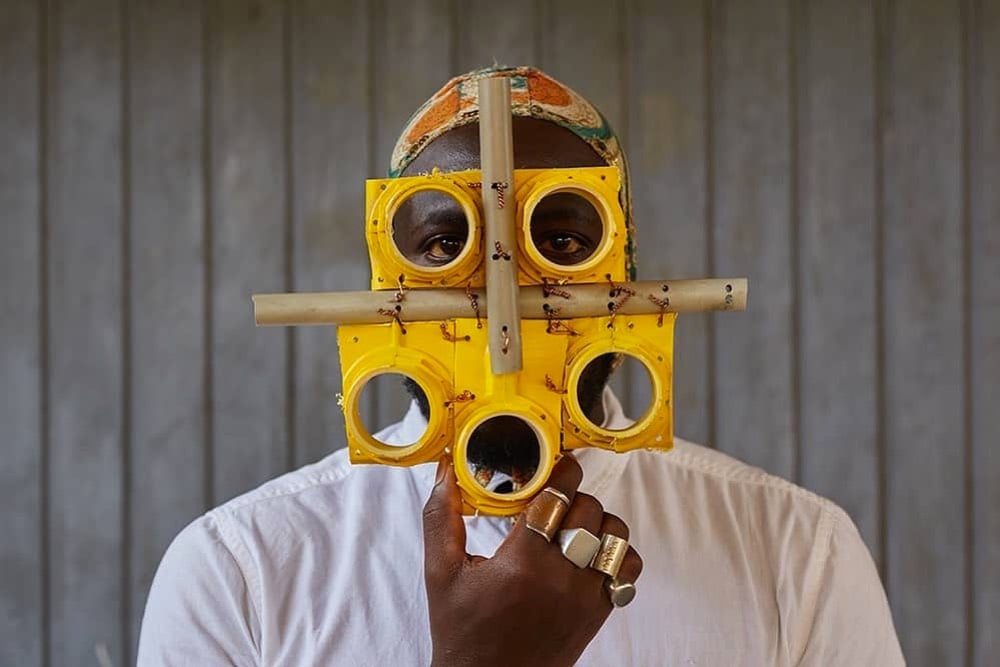
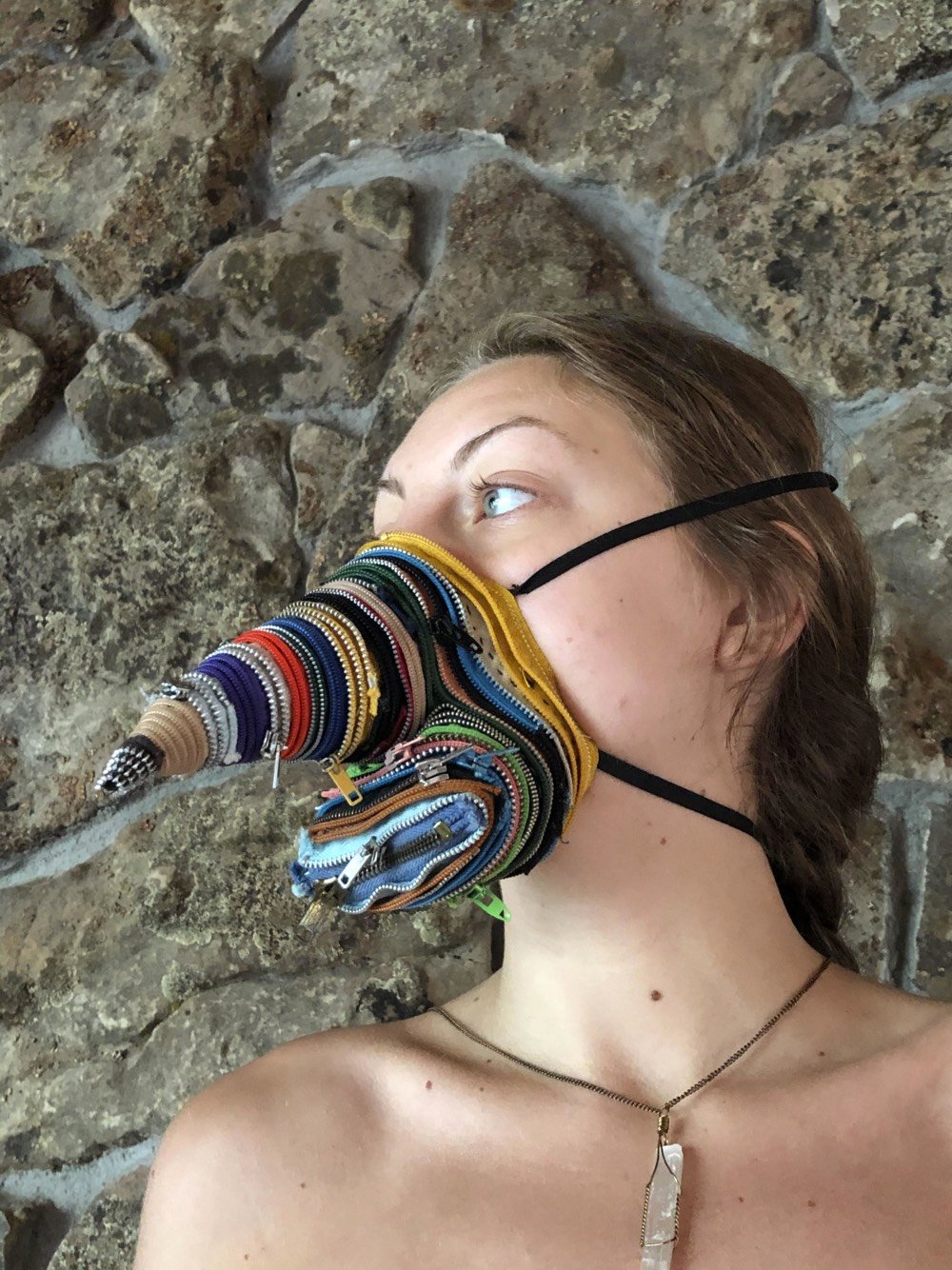
Denver’s Vicki Myhren Gallery is hosting a virtual exhibition called MASK that showcases participating artists’ takes on the now-ubiquitous Covid-19 face masks.
Through this project, we hope to call attention to the significance and signification of masking as an issue of public health and a demonstration of civic responsibility. Equally, MASK calls attention to this newly important medium’s function as an outward mode of self-expression and opportunity for creativity.
(via colossal)
The Wobble Dog 9003i Hot Dog Wobbling Machine
I didn’t know I needed the Wobble Dog 9003i hot dog wobbling machine in my life before watching this video but now I can’t imagine living without it. Q: Can something be both hilarious and kinda-but-not-really erotic at the same time? A: Yes? (via @machinepix)
In August, 55 people attended a wedding reception in Maine. A single guest had Covid-19 and it eventually spread to 176 other people, 7 of whom died. “None of the victims who lost their lives had attended the party.”
How Soy Sauce Is Made Using Traditional Methods
Since 1789, Fueki Syoyu Brewing has been making soy sauce using simple ingredients, big wooden barrels for aging, and traditional methods handed down through the generations to ensure the signature richness and taste of their product. This video from Eater takes us inside the brewery to see how the magic happens.
The Winners of the 2020 Close-Up Photographer of the Year Competition



The winners of the second annual Close-Up Photographer of the Year competition have been announced. You can check out the winners and the finalists on the competition website. The photos above were taken by (from top to bottom) Don Komarechka, Bernhard Schubert, and Gerd A. Günther. (via in focus)
We’re Past the ‘Point of No Return’ on Global Warming, Scientists Warn. “It simply will not stop from cutting manmade greenhouse gasses. We need to do something more in order to stop it.”
Leta Powell Drake, Interviewer Extraordinaire
This clip of Leta Powell Drake interviewing 80s TV & movie stars like Tom Hanks, Telly Savalas, and Gene Hackman is incredible. She was obviously not intimidated by celebrity — leaning in closely to Hackman, she says: “You’ve done some brilliant pictures and you’ve done some stinkers.” And that’s not even her worst burn.
The clips were compiled from interviews that she did for the TV station KOLN/KGIN in Lincoln, NE when celebs would come through town to promote their latest thing. History Nebraska has a full archive of these interviews available on YouTube.
Here’s a video profile of Drake from 2014 and a recent profile. She’s in the Nebraska Broadcasters Association Hall of Fame (alongside Johnny Carson, Tom Brokaw, and Dick Cavett), played a character called Kalamity Kate on TV for several years, and also won city championships in horseshoes, golf, and bowling. Wow. (via @jfrankensteiner)
The 50th Anniversary of the Iconic Exploding Whale
Fifty years ago today, on the beach outside a small town in Oregon, local officials used way too much dynamite (a half ton!) to dispose of a beached whale with a result that seems predictable in hindsight: chunks of whale absolutely everywhere. The explosion was captured on film by local TV station KATU and in the 90s, it went viral on the internet.
As it turns out, that was overkill. Mammalian marine guts spewed everywhere, raining down on townsfolk. A quarter-mile away, cars were smashed with chunks of cetacean carcass.
This story remained a local legend for two decades, until the early ’90s , when the newspaper columnist Dave Barry mentioned seeing footage of the exploding beast. Soon after, this video clip — originally reported by Portland news channel KATU — went viral on the internet, long before “going viral on the internet” was even a thing.
You should watch it if you’ve never seen it, and if you have, you should definitely watch it again today in all of its digitally remastered 4K glory above. I clearly remember the day at work in the mid-90s when someone discovered this video and the entire office came to a halt as we all watched it over and over again in a tiny QuickTime player window on a small computer screen — it’s just as hilarious today as it was back then.
Norway’s Beautiful New Passports
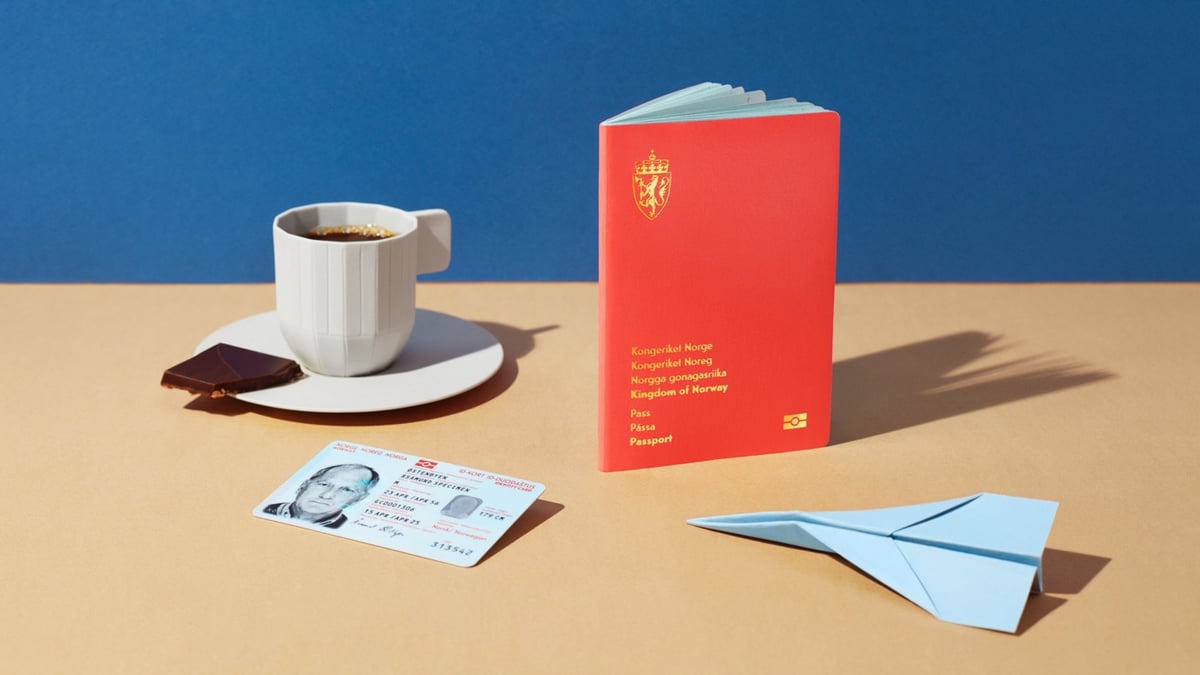
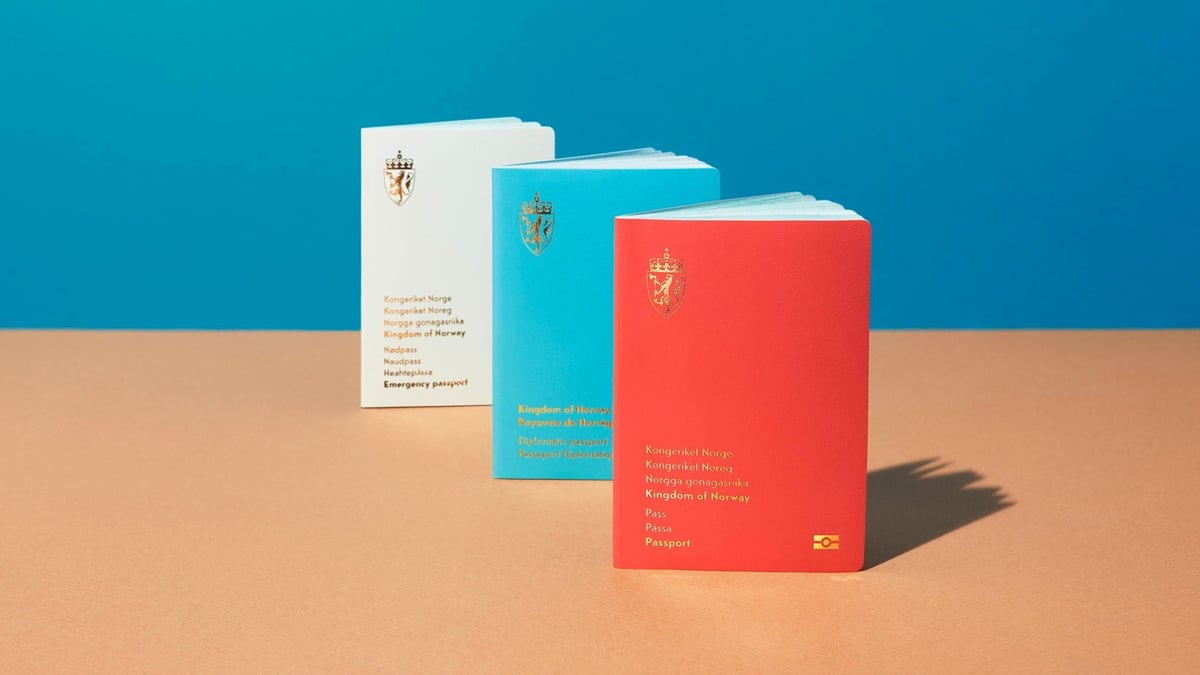
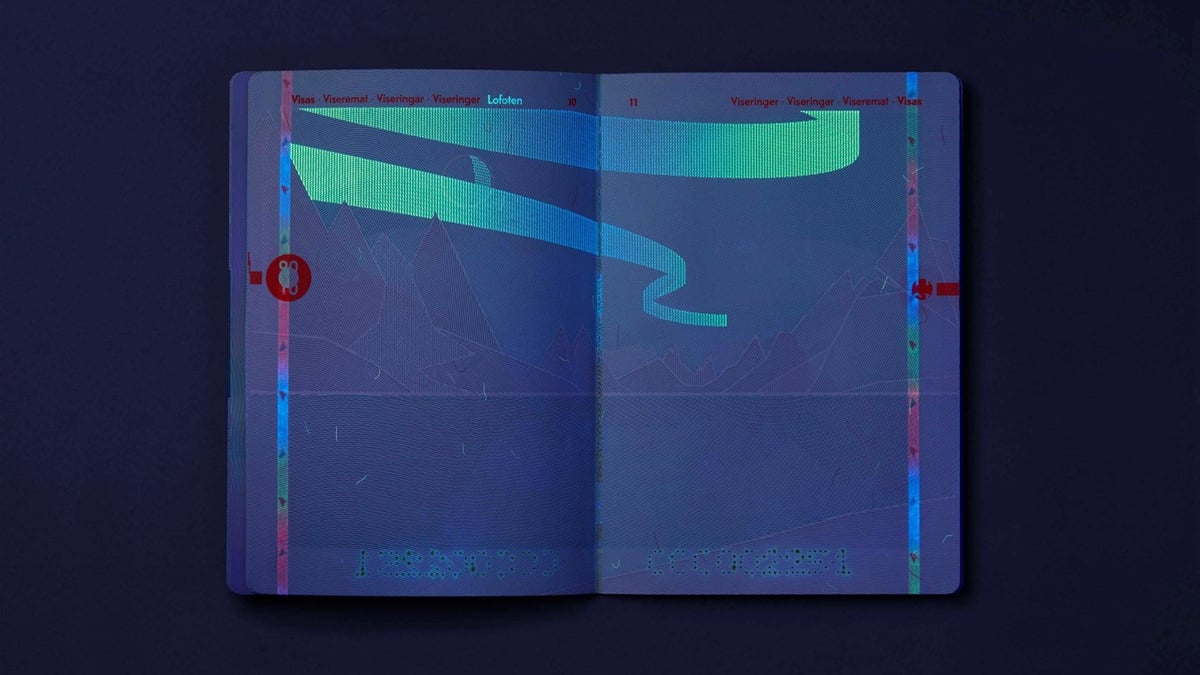
Last year, I shared the concept designs for Norway’s new passports by creative agency Neue. Last month, the first documents using the new design were released. You can see them here.
Aside from a design that makes the passport safer, the passport also has details from Norwegian nature used both as a background illustration and a security element.
When the pages of the passports are placed under UV light, the reproduction of the Norwegian landscape will change from day to night, with, among other things, beautiful northern lights and clouds.
You can see the appearance of the northern lights under UV in the third image above — what a great detail! And I liked this explanation regarding the shared ownership of the passport:
The documents need to ensure identification for its holder and for controlling authorities — domestically as well as abroad. This implies that the ID documents are both a private and a public matter. The document’s holder should feel proud ownership, thus treating the documents carefully and with respect.
When we can all travel again, I will be on the lookout for these sharp-looking documents. And how does one get Norwegian citizenship…? (thx, bård)
A look at the beef between the owner and employees of NYC’s iconic Strand Bookstore. “Why, they wonder, are their fellow employees still out of jobs while the owner gets a government payroll loan and has the money to invest elsewhere?”
How has Uruguay done so well during the pandemic? “Only 3,620 cases and 62 deaths despite sharing borders with Brazil & Argentina, two of the world’s top-10 in overall cases.”
Nobody Is Normal
When I think back to my middle and high school experience, I always felt weird and out of sync with everyone else. I was comparing my insides to my classmates’ outsides and — surprise! — I didn’t measure up. It was only later in life that I realized that this was a universal experience that continues for, as far as I can tell, most of your life? This short promo video for UK youth support hotline Childline (with a Radiohead soundtrack) shows that feeling different is a common experience and urges kids to reach out for help if they’re feeling isolated.
There is nothing wrong with being different from other people. But if feeling different is making you feel isolated or upset, then there are things you can do to feel better.
(via colossal)
The winners of the 2020 AAAS Kavli Science Journalism Awards. Lots of meaty reading here about the pandemic, climate change, and other topics.
Trump is attempting a coup in plain sight. “That this coup probably will not work — that it is being carried out farcically, erratically, ineffectively — does not mean it is not happening, or that it will not have consequences.”
Q: What Is a Hole? A: We’re Not Sure!
How many holes does a donut have? That’s pretty easy: one. What about a straw? Two (one at each end) or just one? (Isn’t a straw just an elongated donut?) Does a coffee mug have one hole or two? Does a bowl have a hole? If no, then what about a hole in the ground or a hole in a wall that doesn’t pass all the way through? Does a basketball have a hole? A Reddit user asked 1600 people how many holes were in various objects and the results are fantastically all over the place.
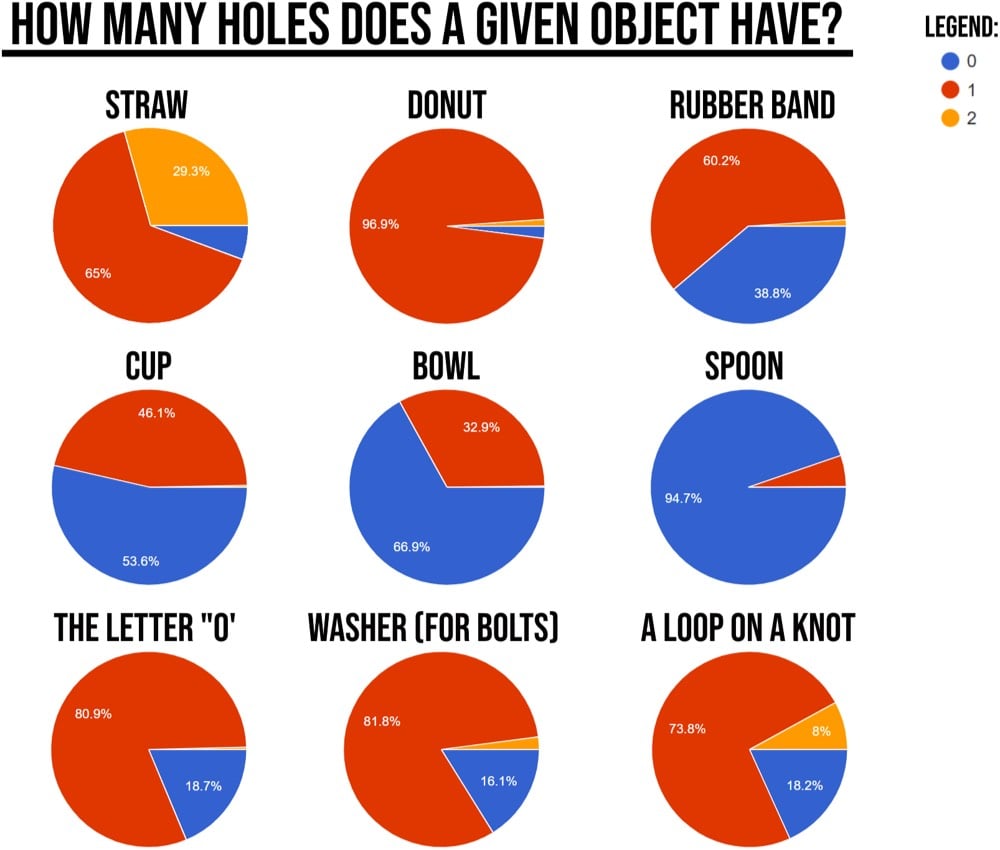
This is a trivial question, but it reveals something interesting about people’s perceptions. The dictionary definition of “hole” includes two main meanings for the purposes of this question: “an opening through something” and “a hollowed-out place”. Mathematics offers another possible meaning:
A hole in a mathematical object is a topological structure which prevents the object from being continuously shrunk to a point. When dealing with topological spaces, a disconnectivity is interpreted as a hole in the space. Examples of holes are things like the “donut hole” in the center of the torus, a domain removed from a plane, and the portion missing from Euclidean space after cutting a knot out from it.
But a hole isn’t clearly defined in math or topology. From What We Talk about When We Talk about Holes in Scientific American:
Here’s my short answer that is also the reason I’m not an algebraic topologist. If you can put it on a necklace, it has a one-dimensional hole. If you can fill it with toothpaste, it has a two-dimensional hole. For holes of higher dimensions, you’re on your own.
That answer isn’t very satisfying. Is there a better way to describe holes? I talked with some of my topologist friends and discovered two things: topologists don’t all agree on what a hole is, and it’s fun and interesting to think about different interpretations of a word whose mathematical definition isn’t completely settled. I think my larger conclusion, in the spirit of the season, is that holes are like Santa Claus: the true meaning is in your heart.
No wonder those poll results are all over the place. But at the same time, it’s interesting that many more people say that donuts have a hole than washers or rubber bands. I guess donut holes have better marketing? As for straws — reason tells me they only have one hole but I know in my heart they have two. (via the whippet)
Could a Peasant Defeat a Knight in Battle? “If a knight came face-to-face with a peasant in battle, then the latter had the odds very much against them.”
No Evidence of Voter Fraud Reported by Election Officials Nationwide
The headline and first few paragraphs of today’s front-page story in the NY Times say it all: The Times Called Officials in Every State: No Evidence of Voter Fraud.
Election officials in dozens of states representing both political parties said that there was no evidence that fraud or other irregularities played a role in the outcome of the presidential race, amounting to a forceful rebuke of President Trump’s portrait of a fraudulent election.
Over the last several days, the president, members of his administration, congressional Republicans and right wing allies have put forth the false claim that the election was stolen from Mr. Trump and have refused to accept results that showed Joseph R. Biden Jr. as the winner.
But top election officials across the country said in interviews and statements that the process had been a remarkable success despite record turnout and the complications of a dangerous pandemic.
Of course, the Republicans have made no fraud claims about states where they did well. Every Republican who the media projected to be the winner has claimed victory on that basis. And if the Democrats were somehow cheating, wouldn’t they have done far better on down-ballot races — presumably hundreds of thousands of fake ballots for Biden would also have gone for Democratic Senate and House candidates as well? The whole thing is obviously absurd.
Powell’s Books Is Releasing a Fragrance that Smells Like a Bookstore
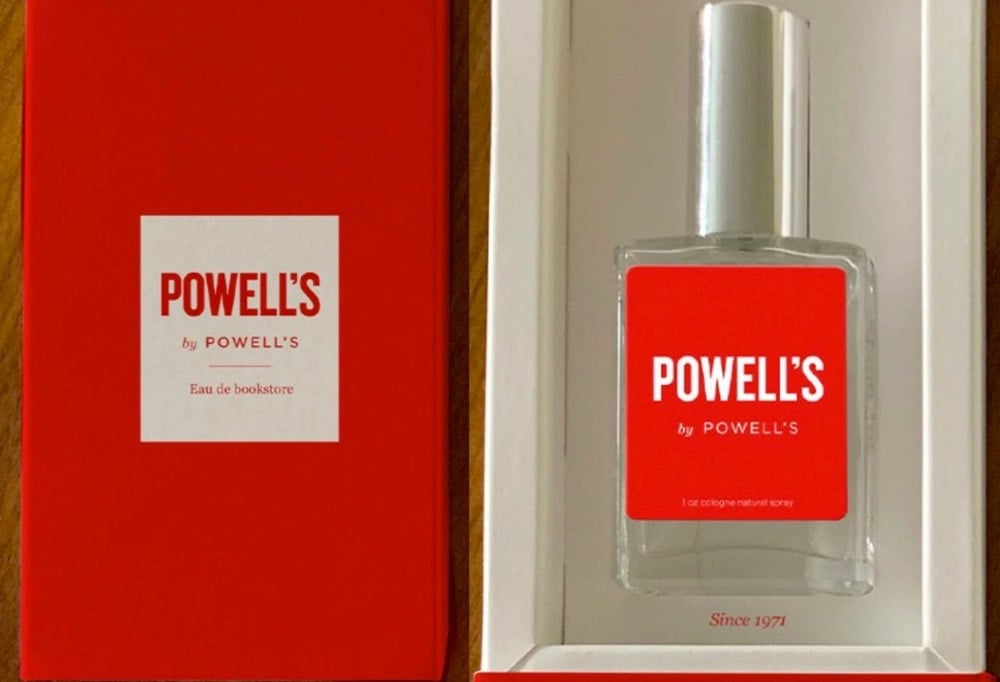
Beloved Portland indie bookseller Powell’s Books is selling a unisex fragrance that smells like a bookstore.
This scent contains the lives of countless heroes and heroines. Apply to the pulse points when seeking sensory succor or a brush with immortality.
According to KOIN, the company noticed that customers missed the smell when they were closed during the pandemic lockdown in the spring.
Powell’s Books is releasing a limited edition unisex fragrance that captures what they said is what customers missed most about Powell’s — the aroma.
Store officials said they surveyed customers about what they missed while the store was temporarily closed by the pandemic. It’s not the books. It’s the smell.
The perfume comes packaged in something that looks like a book, like a hidden bottle of hooch or a gun.
If you can’t get your hands on Powell’s scent, you have other options. Demeter makes a fragrance called Paperback that’s available in a variety of formats (cologne, shower gel, diffuser oil) and Christopher Brosius offers a scent called In The Library in his shop. (via moss & fog)
AlphaGo - The Movie
I missed this back in March (I think there was a lot going on back then?) but the feature-length documentary AlphaGo is now available to stream for free on YouTube. The movie documents the development by DeepMind/Google of the AlphaGo computer program designed to play Go and the competition between AlphaGo and Lee Sedol, a Go master.
With more board configurations than there are atoms in the universe, the ancient Chinese game of Go has long been considered a grand challenge for artificial intelligence. On March 9, 2016, the worlds of Go and artificial intelligence collided in South Korea for an extraordinary best-of-five-game competition, coined The DeepMind Challenge Match. Hundreds of millions of people around the world watched as a legendary Go master took on an unproven AI challenger for the first time in history.
During the competition back in 2016, I wrote a post that rounded up some of the commentary about the matches.
Move after move was exchanged and it became apparent that Lee wasn’t gaining enough profit from his attack.
By move 32, it was unclear who was attacking whom, and by 48 Lee was desperately fending off White’s powerful counter-attack.
I can only speak for myself here, but as I watched the game unfold and the realization of what was happening dawned on me, I felt physically unwell.
Ruby Bridges Tells Her Story
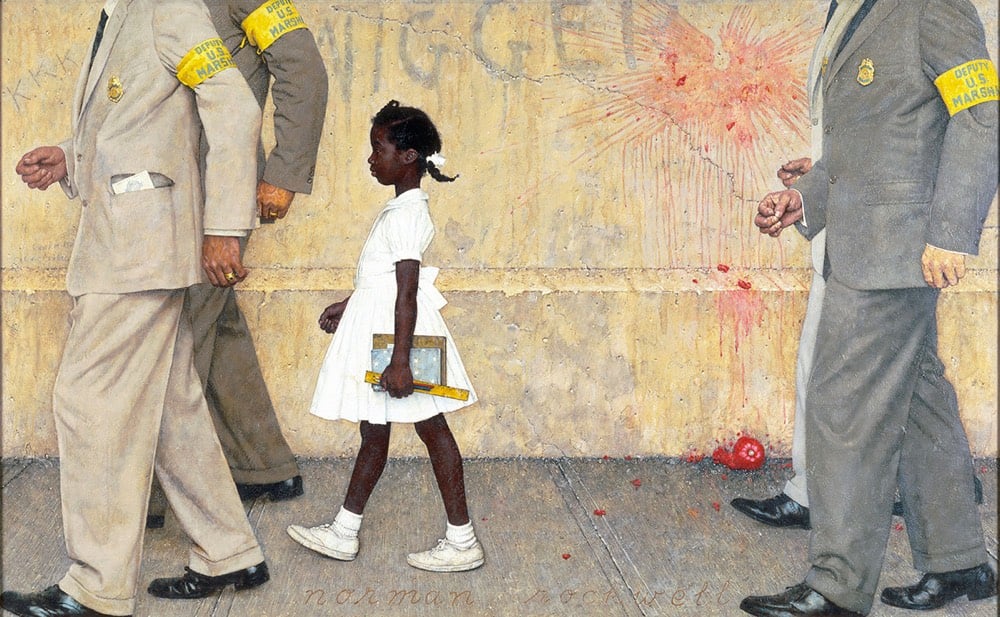
In 1960, six-year-old Ruby Bridges became the first Black student at the newly desegregated William Frantz Elementary School in New Orleans. Escorted to her first day of school by federal marshals, she was immortalized by Normal Rockwell in a 1964 painting called The Problem We All Live With. Bridges has a new book out today called This Is Your Time.
Written as a letter from civil rights activist and icon Ruby Bridges to the reader, This Is Your Time is both a recounting of Ruby’s experience as a child who had no choice but to be escorted to class by federal marshals when she was chosen as one of the first black students to integrate New Orleans’ all-white public school system and an appeal to generations to come to effect change.
In a segment on NPR’s Weekend Edition, Bridges shared some of her story from the book.
The first day that I arrived with federal marshals, they rushed me inside of the building. And 500 kids walked out of school that first day and they never returned.
[Making friends] did not come easy because I heard kids, there were days when I would go into this coat closet to hang up my coat and I could hear kids laughing and talking, but I never saw them. Later on, I came to realize that they were being hidden from me in another classroom.
And that was because there were some white parents who actually crossed that picket line and brought their kids to school. But the principal who was part of the opposition, she would hide them. And even though I was complaining — or at least mentioning it to Mrs. Henry, she would never say anything to me, but she was actually going to the principal and saying, if you don’t allow those kids to come together, because the law has now changed, then I’m going to report you to the superintendent. And so I think after months of that, we were allowed to come together.
Bridges is only 66 years old today — this was all not so long ago.
Update: Sad news: Ruby’s mother, Lucille Bridges, died yesterday at the age of 86.
Her daughter went on to become an icon of the Civil Rights Movement, memorialized in Norman Rockwell’s famous painting “The Problem We All Live With” which depicts a tiny Ruby in a white dress carrying her notebooks and a ruler surrounded by much taller U.S. Marshals. But Ruby Bridges once credited her parents as the forces behind her history-making achievement.
“My parents are the real heroes,” the U.S. Marshals Service once quoted her as saying during a ceremony at an art gallery showing the painting. “They (sent me to that public school) because they felt it was the right thing to do.”
Take some time to read about the Kristallnacht (violent anti-Jewish pogroms), which took place in Germany and German-occupied areas 82 years ago yesterday & today. We need to remember well the dangers of racist, nationalist authoritarianism.
Holy crap, watch this video of someone exhaling in a N95 mask with a value vs. an unvalved mask. If you’re still somehow wearing a valved mask thinking it will protect others from your possible infection, please find a better option.
“Voting Trump Out Is Not Enough”
For the New Yorker, Keeanga-Yamahtta Taylor writes that as much noise and pain that Donald Trump generated while he was in office, it can’t hold a candle to America’s systemic problems, which remain unaddressed by both major parties.
Like tens of millions of Americans, I voted to end the miserable reign of Donald J. Trump, but we cannot perpetuate the election-year fiction that the deep and bewildering problems facing millions of people in this country will simply end with the Trump Administration. They are embedded in “the system,” in systemic racism, and the other social inequities that are the focus of continued activism and budding social movements. Viewing the solution to these problems as simply electing Joe Biden and Kamala Harris both underestimates the depth of the problems and trivializes the remedies necessary to undo the damage. That view may also confuse popular support for fundamental change, as evidenced by Trump’s one-term Presidency, with what the Democratic Party is willing or even able to deliver.
I missed this news last month: George Miller is directing a Mad Max prequel called Furiosa. Anya Taylor-Joy (Beth in The Queen’s Gambit) will play Furiosa.
What if we treated the American Presidency as the civil service job that it is? “We don’t think of the Presidency as a civil service position like working at the DMV or delivering the mail. But that’s what it is. It’s another government service job.”
Head-Stabilized Champion Hurdler
This is a video of world champion Grant Holloway doing the 110-meter hurdles that’s been modified to keep his head right in the middle of the video. While champion hurdlers don’t keep their heads as still as birds do when hunting, Holloway’s relative lack of motion is incredible.
In this view, you can clearly see how expert hurdlers don’t jump their whole bodies over the hurdle (like Super Mario or something) — it’s more that they just bring their lower bodies up over the hurdles while their heads & shoulders remain more or less the same height from the ground. There’s hardly any lateral motion either — very little wasted energy here.
Lessons from the Ancient World about the Political Collapse and Recovery of Self-Governing Communities
This is a fascinating post by historian Bret Devereaux, who specializes in ancient history (esp. Rome), that looks at ancient self-governing democracies and republics in the Greek and Roman world and describes how they fell into crisis and, crucially, how they were able to recover to avoid losing that self-governance.
But in that large sample size, we also get a sense of what solutions succeed and what solutions fail to hold together a self-governing community in these sorts of pressures. Beset by repeated political crises from 494 to 287 (known as the Struggle of the Orders), the Roman Republic repeatedly survived and grew stronger through compromise and by constructive, inclusive redefinition of the republic to include a broader range of people (not merely the patrician elite, but also the plebeian elite). In no small part, that success seems to have been motivated by the avowed need of elite patricians for the support of the plebeian commons in order to campaign, since the plebeians made up most of the army.
In stark contrast, the effort by conservative (in the general sense, not in the American sense) elements of the Roman senate to ‘hold the line’ and permit no compromise on questions of land reform and citizenship in the Late Republic led quite directly to the outbreak of civil war in 91 (with the Italian allies) and in 88 (between Romans) and consequently to the collapse of the Republic. Initially, the influence and raw power of the elite was sufficient to squash efforts at reform (including the murder of some prominent reformers), but in the long run the discontent those crackdowns created laid the fertile ground for the rise of demagogic military leaders to supplant the Republic entirely, culminating in first Caesar and then Octavian doing just that. In an effort to compromise on nothing, the Roman elite lost everything.
Devereaux then draws a parallel to the 2020 election:
In short, Joe Biden is running on a platform of compromise and a constructive, inclusive redefinition of the polity which explicitly welcomes past opponents to join him at the table. To me, reasoning from historical example, that seems like the correct answer to the current moment.
On the other hand, we have a different candidate (and current President) who is running on a promise to ‘win’ the stasis by main force, to dominate and to win, indeed, until he (or we) get tired of winning, to escalate the tensions to the final victory of the faction. This is exactly the approach that I think a sober reading of historical examples warns us is likely doomed to failure, regardless of what one thinks of the underlying policy aims (which might well have been achieved without the rhetoric and practice of escalation). I cannot help but think that, as happened in the last decades of the Roman Republic, rewarding this sort of rhetoric and behavior will produce more of it from both parties and put our republic on a dangerous path.
Former Ballerina with Alzheimer’s Recreates Her Swan Lake Choreography
As a ballerina in NYC during the 60s, Marta C. González undoubtably performed Tchaikovsky’s Swan Lake hundreds or even thousands of times. González passed away recently — perhaps from complications due to her Alzheimer’s, which can affect a person’s memory and movements in profound ways — but she had one last chance to revisit her ballet days before she died. In the video above, you can see how, as she starts to listen to Swan Lake in a pair of headphones, she reanimates and begins performing the dance choreography in her wheelchair. Clips from what I’m assuming is her past Swan Lake performance are interspersed throughout the video. What a lovely moment.
“America’s Next Authoritarian Will Be Much More Competent”
Citing international precedent and America’s anti-majoritarian systems, Zeynep Tufekci argues that the next authoritarian who runs for President will be much more competent and dangerous.
The Electoral College and especially the Senate are anti-majoritarian institutions, and they can be combined with other efforts to subvert majority rule. Leaders and parties can engage in voter suppression and break norms with some degree of bipartisan cooperation across the government. In combination, these features allow for players to engage in a hardball kind of minority rule: Remember that no Republican president has won the popular vote since 2004, and that the Senate is structurally prone to domination by a minority. Yet Republicans have tremendous power. This dynamic occurs at the local level, too, where gerrymandering allows Republicans to inflate their representation in state legislatures.
The situation is a perfect setup, in other words, for a talented politician to run on Trumpism in 2024. A person without the eager Twitter fingers and greedy hotel chains, someone with a penchant for governing rather than golf. An individual who does not irritate everyone who doesn’t already like him, and someone whose wife looks at him adoringly instead of slapping his hand away too many times in public. Someone who isn’t on tape boasting about assaulting women, and who says the right things about military veterans. Someone who can send appropriate condolences about senators who die, instead of angering their state’s voters, as Trump did, perhaps to his detriment, in Arizona. A norm-subverting strongman who can create a durable majority and keep his coalition together to win more elections.
You should also read Tufekci’s related thread, where she responds to some comments and criticism of the piece.
This isn’t some rare thing that just happened because of weird circumstances. This is a playbook that works. This is a global playbook on the rise. This is a playbook found in America’s past, too. Realism is the true basis for hope.
We have to keep pushing to make sure no populist authoritarians ever get their hands on the Presidency again.
An interview with former chess champion Linda Diaz about what The Queen’s Gambit got right & wrong. “She’s really aggressive. And I was also an aggressive player. And so it comes off as ‘you’re impatient,’ and really it’s that you’re creative…”
This is pitch perfect: I Guess I Just Expected a Little More From This Country. “How could a people that had to be explicitly told not to eat Tide Pods be so short-sighted?”
Biden’s Plans for Halting the Unchecked Spread of Covid-19 in the US
This morning, the transition team for President-elect Joe Biden announced the members of his Covid-19 task force.
The list includes Rick Bright, the former head of the vaccine-development agency BARDA ousted by the Trump administration in April; Atul Gawande, the surgeon, writer, and recently departed CEO of Haven, the joint JP Morgan Chase-Berkshire Hathaway-Amazon health care venture; and Luciana Borio, a former Food and Drug Administration official and biodefense specialist.
Biden has cast the escalating Covid-19 crisis as a priority for his incoming administration. The task force, he said, would quickly consult with state and local health officials on how to best prevent coronavirus spread, reopen schools and businesses, and address the racial disparities that have left communities of color harder hit than others by the pandemic.
From Biden’s transition website, here’s the Biden-Harris administration’s seven-point plan to beat COVID-19 (which is the first item in the site’s “Priorities” menu). The seven points are:
- Ensure all Americans have access to regular, reliable, and free testing.
- Fix personal protective equipment (PPE) problems for good.
- Provide clear, consistent, evidence-based guidance for how communities should navigate the pandemic — and the resources for schools, small businesses, and families to make it through.
- Plan for the effective, equitable distribution of treatments and vaccines - because development isn’t enough if they aren’t effectively distributed.
- Protect older Americans and others at high risk.
- Rebuild and expand defenses to predict, prevent, and mitigate pandemic threats, including those coming from China.
- Implement mask mandates nationwide by working with governors and mayors and by asking the American people to do what they do best: step up in a time of crisis.
This looks like what the plan should have been from the beginning. Of particular note, under the point about testing:
Stand up a Pandemic Testing Board like Roosevelt’s War Production Board. It’s how we produced tanks, planes, uniforms, and supplies in record time, and it’s how we will produce and distribute tens of millions of tests.
Establish a U.S. Public Health Jobs Corps to mobilize at least 100,000 Americans across the country with support from trusted local organizations in communities most at risk to perform culturally competent approaches to contact tracing and protecting at-risk populations.
Over the past week, as Americans voted and then held their breath for the results of the election, over 750,000 Americans tested positive for Covid-19. Based on the current case fatality rate of 2.4%, over 18,000 of those people will die in the days and weeks ahead. Many more will suffer long-term health effects because of the disease and struggle emotionally, financially, and spiritually in the months ahead. I really really hope there’s enough of a spirit of togetherness and cooperation left in America for a science-based plan like this to work in controlling a disease that’s killed almost 230,000 people. We — all Americans — need this so so much.
A toolkit for volunteering for the Georgia US Senate runoff races supporting the Raphael Warnock & Jon Ossoff campaigns. Includes places to donate, local orgs to support, how to phonebank, etc.
Initial Data Shows Covid-19 Vaccine Is More than 90% Effective
In a press release (and not a paper in a peer-reviewed journal) based on a preliminary outside review of data from its phase 3 trial, Pfizer says its Covid-19 vaccine was more than 90% effective in preventing the disease.
The company said that the analysis found that the vaccine was more than 90 percent effective in preventing the disease among trial volunteers who had no evidence of prior coronavirus infection. If the results hold up, that level of protection would put it on par with highly effective childhood vaccines for diseases such as measles. No serious safety concerns have been observed, the company said.
I really hope this analysis holds up when more data from the study is released:
The data released by Pfizer Monday was delivered in a news release, not a peer-reviewed medical journal. It is not conclusive evidence that the vaccine is safe and effective, and the initial finding of more than 90 percent efficacy could change as the trial goes on.
The world, and the United States, could really really use some good news like this about the pandemic.
Update: Here’s Pfizer’s press release. And a thread from Dr. Natalie Dean on how she is interpreting this news (“Celebrate, but let the process play out over time as intended.”)
Pfizer’s first analysis was planned for 32 events, which they pushed back after discussions with FDA. But by the time they analyzed the data, 94 had accrued. This shows how quickly trials can generate results when placed in hotspots (and how much transmission is ongoing!).
These vaccines are tested until a certain number of infections happen. So you have this interesting paradoxical situation where if a potential vaccine is more successful at curbing infection, the longer it takes for the study to conclude. You get a better vaccine but wait longer for it. Countering that are the rising transmission counts in the US — more community transmission will get you to the target number of infections more quickly.
Update: From virologist Dr. Florian Krammer, a thread about what Pfizer and other companies will be looking for in terms of the efficacy of vaccines in a number of different situations. Overall, he is optimistic about these preliminary results. And here’s a FAQ about the vaccine from the NY Times.
Another open question is whether children will get protection from the vaccine. The trial run by Pfizer and BioNTech initially was open to people 18 or older, but in September they began including teenagers as young as 16. Last month, they launched a new trial on children as young as 12 and plan to work their way to younger ages.
Update: A very simplified explanation of Pfizer’s RNA-based vaccine.
Awkward, a Short Film about Uncomfortable Moments
Awkward is an animated short film from animator/illustrator Nata Metlukh about some of life’s less graceful moments — the “after you” dance of bumping into someone on the street, a disliked haircut in the barber chair, incorrect assumptions, and mistakenly waving hello to someone you don’t know. (via colossal)
This is a nice map, but we do this every four years. Misleading area-based US election maps have been “fixed” for decades. It’s just that the media won’t stop using them.
An Oral History of ‘Marge vs The Monorail’, the Episode That Changed ‘The Simpsons’. Always one of my favorites & quoted it endlessly w/ friends in college.
FDR’s Second Bill of Rights
In his 1944 State of the Union address, President Franklin Roosevelt encouraged Congress to turn its attention to what he called “a second Bill of Rights”, legislation that would ensure all American citizens “equality in the pursuit of happiness”. Roosevelt argued that the United States had grown large enough and economically powerful enough to support this effort.
Here’s an excerpt from his address:
We have come to a clear realization of the fact that true individual freedom cannot exist without economic security and independence. “Necessitous men are not free men.” People who are hungry and out of a job are the stuff of which dictatorships are made.
In our day these economic truths have become accepted as self-evident. We have accepted, so to speak, a second Bill of Rights under which a new basis of security and prosperity can be established for all — regardless of station, race, or creed.
Among these are:
- The right to a useful and remunerative job in the industries or shops or farms or mines of the nation;
- The right to earn enough to provide adequate food and clothing and recreation;
- The right of every farmer to raise and sell his products at a return which will give him and his family a decent living;
- The right of every businessman, large and small, to trade in an atmosphere of freedom from unfair competition and domination by monopolies at home or abroad;
- The right of every family to a decent home;
- The right to adequate medical care and the opportunity to achieve and enjoy good health;
- The right to adequate protection from the economic fears of old age, sickness, accident, and unemployment;
- The right to a good education.
All of these rights spell security. And after this war is won we must be prepared to move forward, in the implementation of these rights, to new goals of human happiness and well-being.
After WWII, many countries in Europe came to similar conclusions and enacted reforms to offer these rights to their citizens. In America, aside from the significant efforts of the Johnson administration in the 60s, we went in different direction, doubling down on inequality in the pursuit of happiness.
What Would We Experience If Earth Spontaneously Turned Into A Black Hole?
Let’s say the Earth turned into a black hole. What would happen to someone standing on the surface and for how long would it happen? From Ethan Siegel:
As spectacular as falling into a black hole would actually be, if Earth spontaneously became one, you’d never get to experience it for yourself. You’d get to live for about another 21 minutes in an incredibly odd state: free-falling, while the air around you free-fell at exactly the same rate. As time went on, you’d feel the atmosphere thicken and the air pressure increase as everything around the world accelerated towards the center, while objects that weren’t attached to the ground would appear approach you from all directions.
2020 Should Be the Last Time We Vote Like This. The US system of voting is terrible and unfair and racist.
An interview with James Nestor, author of a recent book on the “lost art” of breathing. Inhaling through the nose “can trigger different hormones to flood into our bodies, how it can lower our blood pressure…”
“Young people with COVID-19 who are asymptomatic are at risk for developing potentially dangerous inflammation around the heart.” In a recent study, 1/3 of student athletes w/ Covid showed “evidence of heart abnormalities”.
Critics look back on their reviews that they got wrong. “Daft Punk were incredibly prescient: play Discovery today and it sounds utterly contemporary. My review, on the other hand, has not aged so well.”
Twitter accounts are getting TV shows now. Ava DuVernay is doing a @OnePerfectShot series for HBO Max celebrating and discussing “the best shots in film history”.
Ted Lasso started as a character in a 2013 NBC Sports promo for the network’s Premier League coverage. I am glad the character evolved from the meaner one in this spot…
How to Be at Home
For the National Film Board of Canada, director Andrea Dorfman and poet Tanya Davis collaborated on this short film about how to stay connected with ourselves and feel a connection with others while spending time physically apart from other people. I liked this bit about hugging a tree:
Go outside if you’re able, breathe the air
there are trees for hugging
don’t be embarrassed
it’s your friend, it’s your mother, it’s your new crush
lay your cheek against the bark, it’s a living thing to touch
See also Davis and Dorfman’s previous collaboration: How to Be Alone. (thx, scotty)
A former chess master & columnist grades The Queen’s Gambit on its chess authenticity. “The series is one of the best and most successful screen adaptations of the game.”
Chad Scira responsibly reported a bug to Chase regarding their credit card rewards points (you could generate free points by transferring in a certain way). Chase responded by cancelling all of his credit cards and bank accounts.
Tamir Rice would have been old enough to vote today. “Keep him and others without a voice in mind as we use our voices in their stead.”
Vote

I just got back from voting. (For Joe Biden, just to be clear.) I live in a small town in Vermont, so that means there was no line (it took five minutes from when I got out of my car to when I got back into my car) and no real or imagined threat to my desire to vote (bad Covid hygiene, protestors, armed poll watchers). It felt really safe; it felt like voting should feel everywhere in America but doesn’t. We have a lot of work to do to guarantee even basic voting rights for everyone in America, and I hope my vote today was a small step in that direction. (Vote artwork by Alexa Meade.)
A visualization of the role of superspreading in the Covid-19 pandemic. In a situation like this where 10-20% of the people are responsible for 70-80% of the spread, stopping those spreading opportunities is key.
Softbody Tetris
I thought you could use a video of some fuzzy Tetris bricks that automagically ease/ooze into their proper places. That’s it. That’s the post. (via @Remember_Sarah)
What Gordon Parks Saw
Gordon Parks was a novelist, poet, musician, composer, painter, and film director, but he was best known for his photography. In this video, Evan Puschak takes a look at Parks’ photography, from his FSA photos taken in the 40s to his photo essays for Life magazine. What a life, what a career. Here are just a few of Parks’ photos; I encourage you to check out the rest.

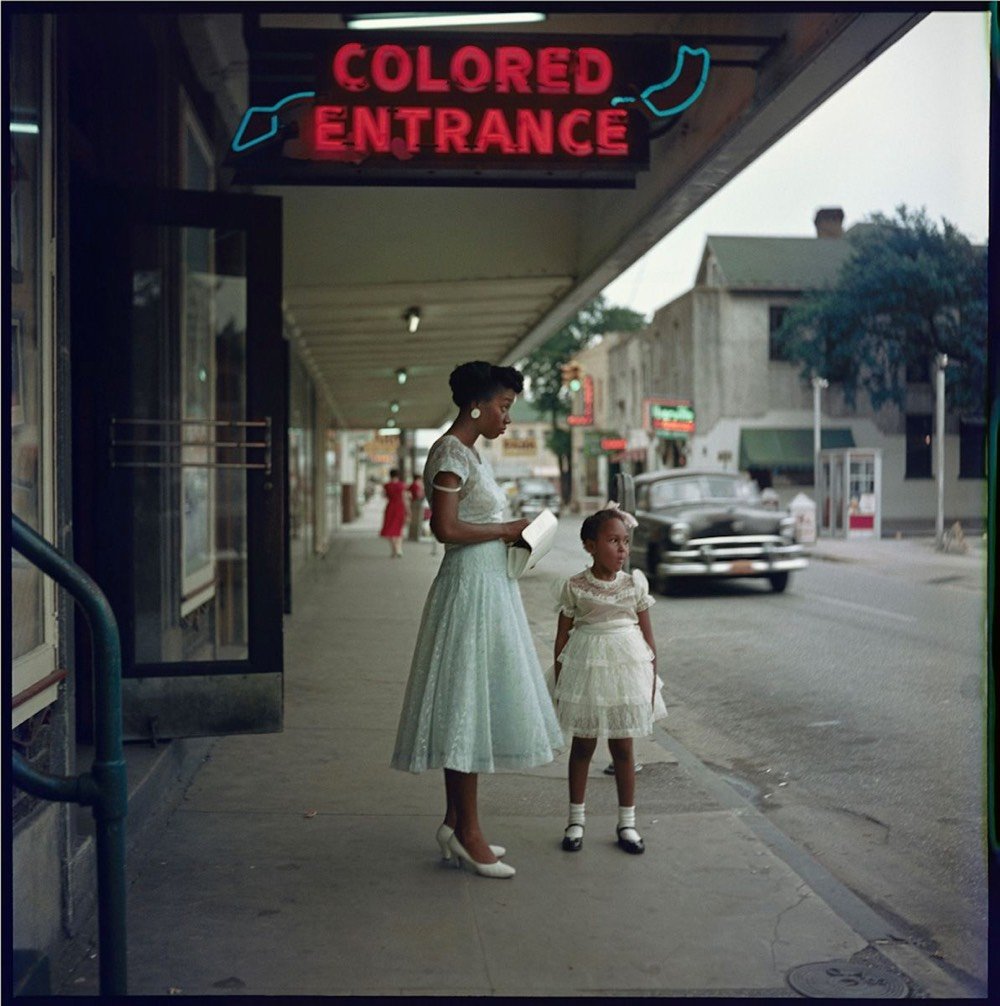
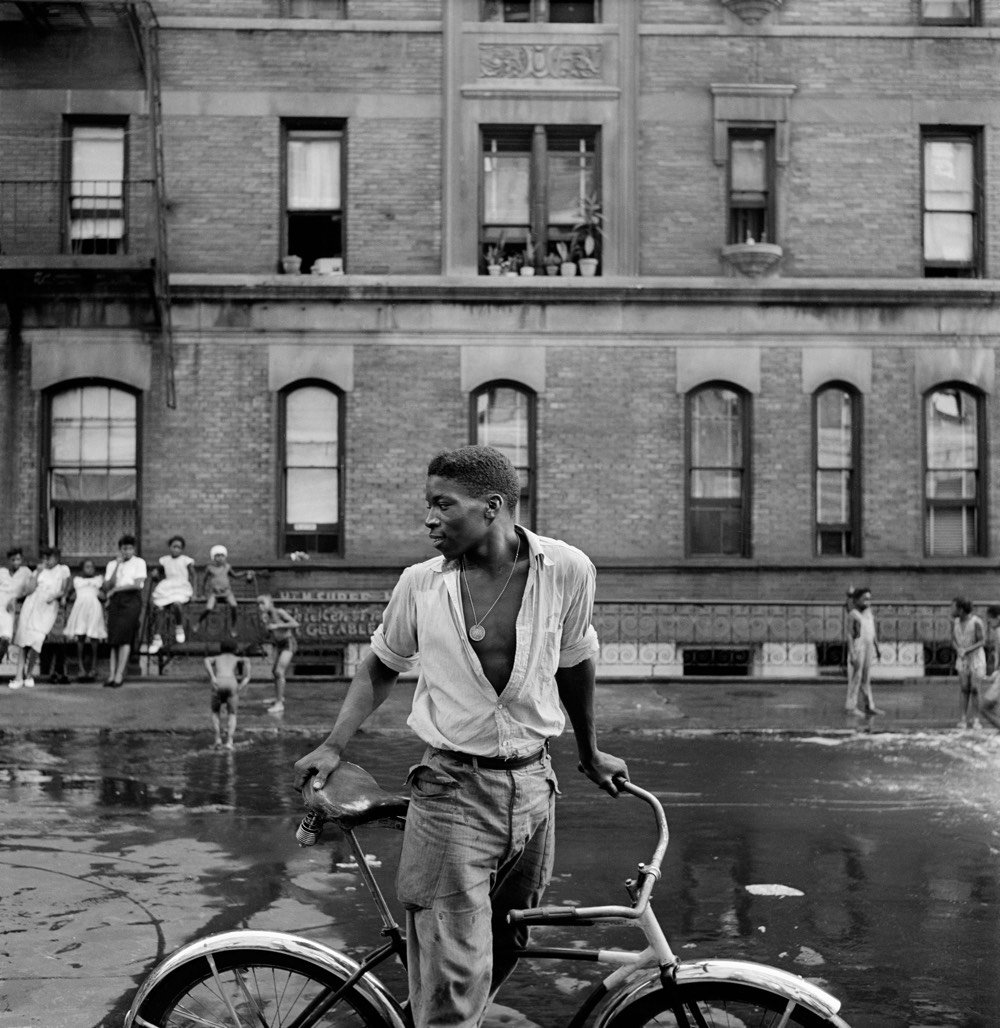

Lovely Illustrations of Plants and Wildlife in the English Countryside
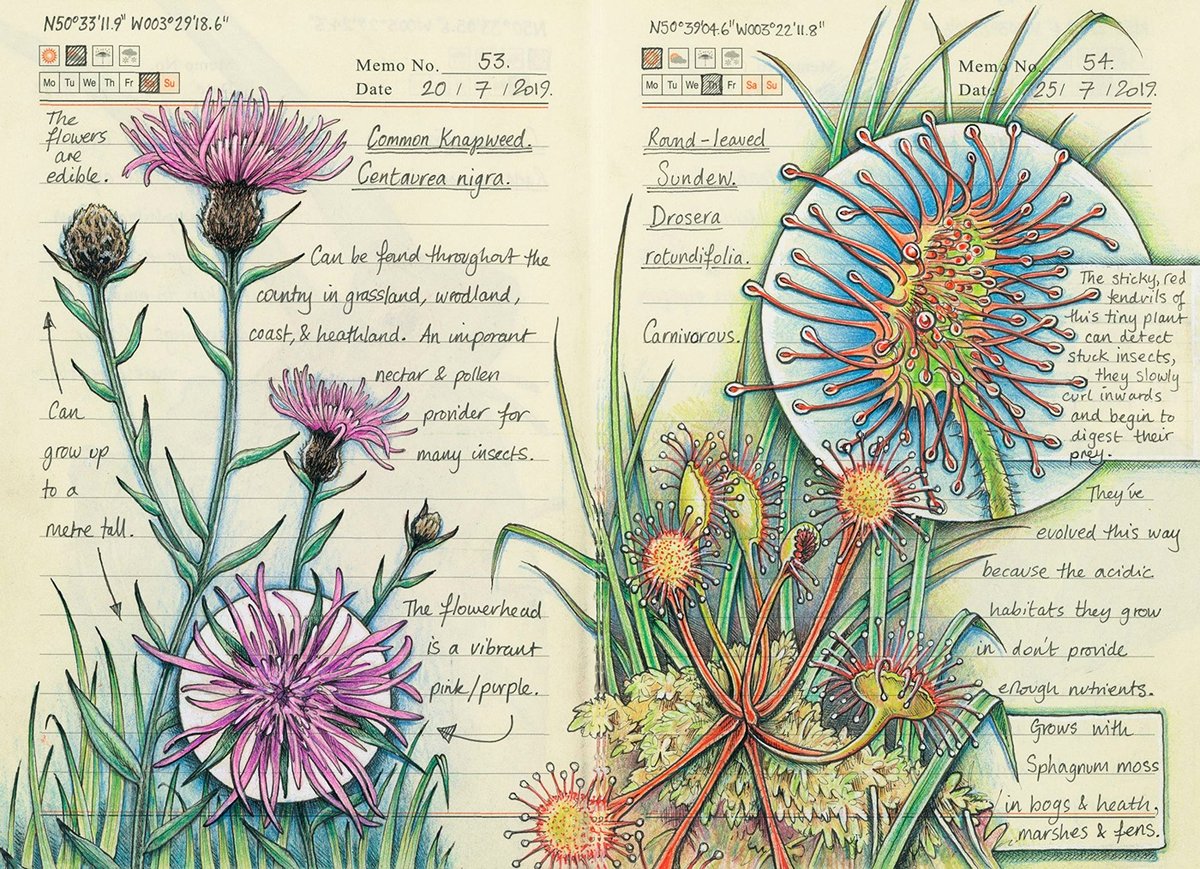
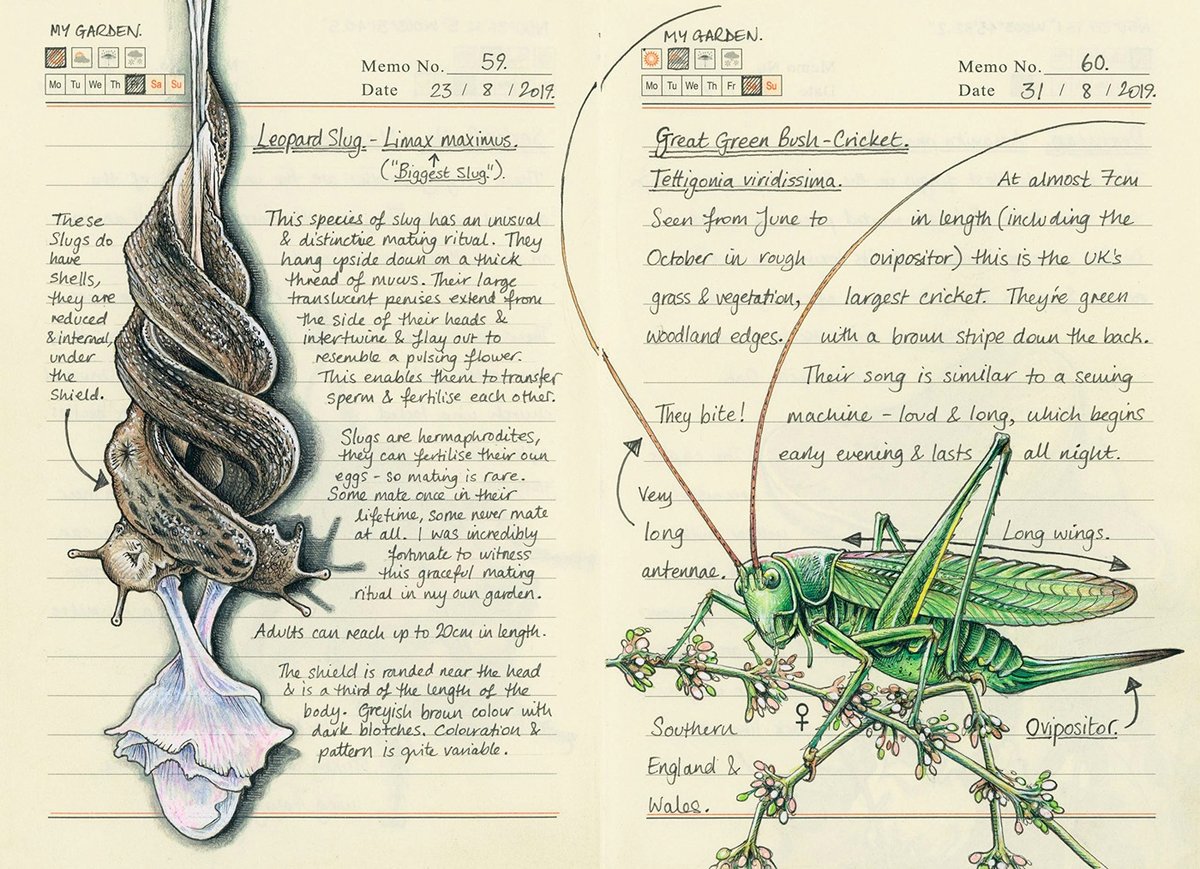
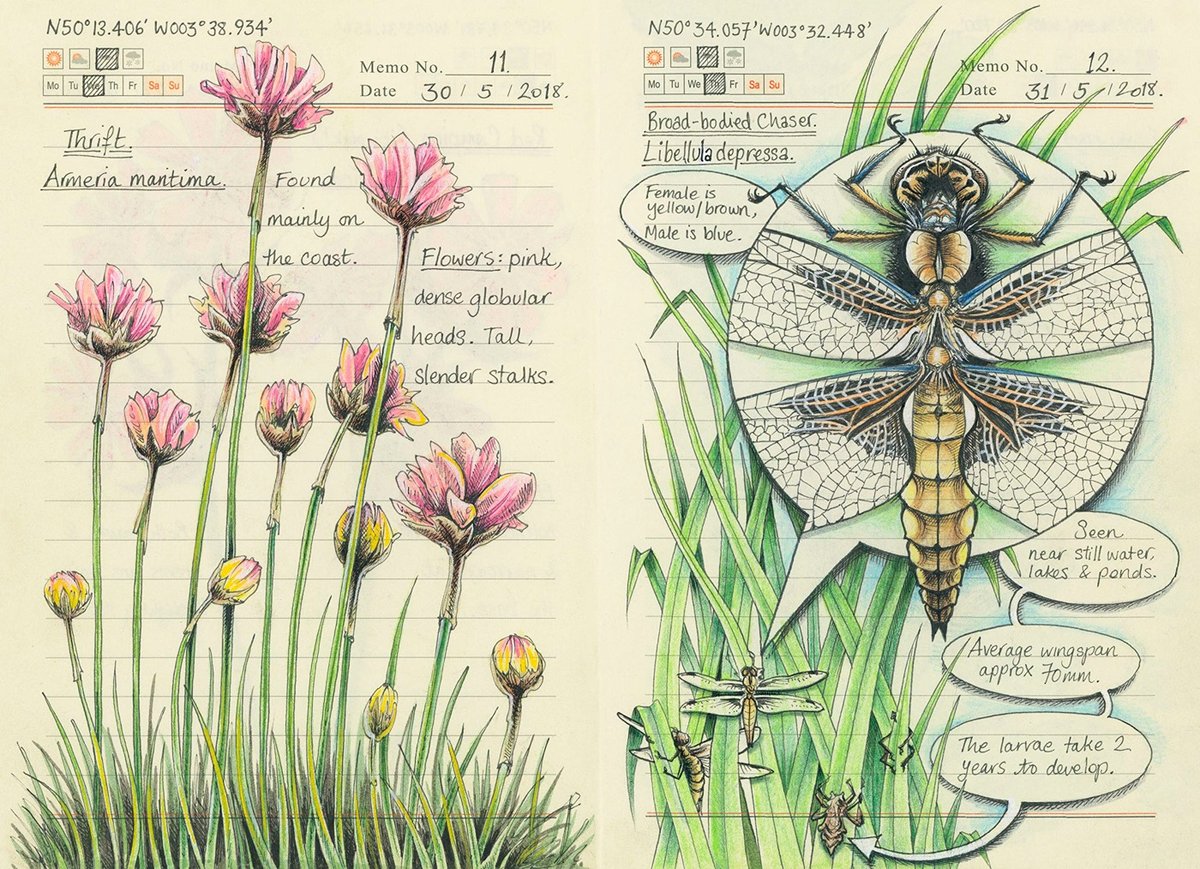
Just enjoying Jo Brown’s illustrations today. Using a Moleskine notebook, she sketches plants and wildlife near her home in Devon, England. A replica of that nature journal called Secrets of a Devon Wood has been recently published in the UK (US edition is out soon — Amazon is the only place I could find it). You can check out more of her artwork on Instagram. (via colossal)
An Incomplete History of White Election Violence. “No, my friends, America is not ‘better than this.’”
An analysis of how police misconduct complaints are handled in Philadelphia. “Not only are the investigation and findings processes more dismissive toward Black complainants, they are more punitive toward Black officers.”
The AI Who Mistook a Bald Head for a Soccer Ball
Second-tier Scottish football club Inverness Caledonian Thistle doesn’t have a camera operator for matches at their stadium so the club uses an AI-controlled camera that’s programmed to follow the ball for their broadcasts. But in a recent match against Ayr United, the AI controller kept moving the camera off the ball to focus on the bald head of the linesman, making the match all but unwatchable. No fans allowed in the stadium either, so the broadcast was the only way to watch.
How Masks Protect Us from Covid-19
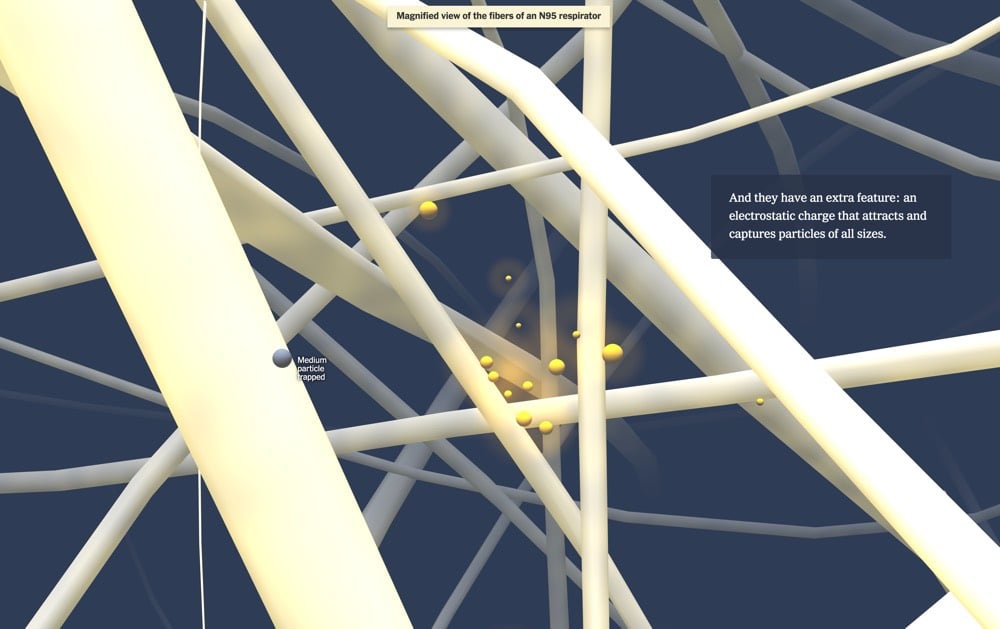
The NY Times has a fantastic visualization on how face masks help keep us safe from catching Covid-19 by taking readers on a journey through a mask to see how they block aerosols and droplets.
A lot of the pushback around the efficacy of masks from non-scientists focuses on the size of the droplets and aerosols (super tiny) compared to the gaps between the fibers in the masks (relatively large). Intuitively, it seems like masks don’t stand a chance of stopping anything. But as this visualization shows, multiple layers of fibers do the job quite well. Masks don’t work like sieves, which will let every particle smaller than the holes through the mesh. Instead, imagine shooting a BB gun into a thick stand of trees — no one tree stands a good chance of getting hit by the BB but the forest will stop it eventually.
N95, KN95, and masks made from polypropylene have an extra weapon against particles: the fibers carry an electrostatic charge that attracts particles to trap them. Picture our BB flying through a forest of magnetic trees — it’s got a much better chance of being captured that way.
The visualization also touches on the importance of making sure your mask fits properly. The best masks fit tightly around the edges and include a space around your nose and nostrils. Masks with unfiltered valves should not be used — you’re just breathing virus out into the air. It’s been 8-9 months now that we’ve been dealing with the pandemic and there will be many more months of wearing masks. If your mask is fits poorly around your nose, your straps aren’t tight enough, you need to fuss with it after putting it on, have a mask with a valve, or (god forbid) are still just wearing a bandana, please please do yourself and others a favor and upgrade your mask. High-quality, well-made masks are much easier to find now than 6-8 months ago.1 If you can’t afford a proper mask, email me and I’ll buy you one. Masks are one of the most successful low-tech interventions we can do to prevent the spread of Covid-19, and the better our masks, the more effective they will be.
I am hesitant in recommending particular masks because I am not a doctor or scientist, but you might want to look at Airpop’s masks. I also recently bought some Vida KN95s (but have not worn one yet). My daily mask is this Allett mask that combines a cotton layer with a non-woven polypropylene layer (I wouldn’t wear this on a plane for 4 hours but for 10 minutes in the grocery store in Vermont where community transmission levels are low, it’s fine). It’s more comfortable than a straight KN95 and fits my face perfectly — no “bunching up” gap between the ear loops or around the nose. Disposable surgical masks are very easy to find — they are better than wearing a bandana, valved mask, or even a thin cotton mask.↩
Jeff Bridges updates us on his cancer diagnosis. “This cancer is making me appreciate my mortality, appreciate impermanance. I’m realizing if I have shit to share, now’s the time.”




Stay Connected